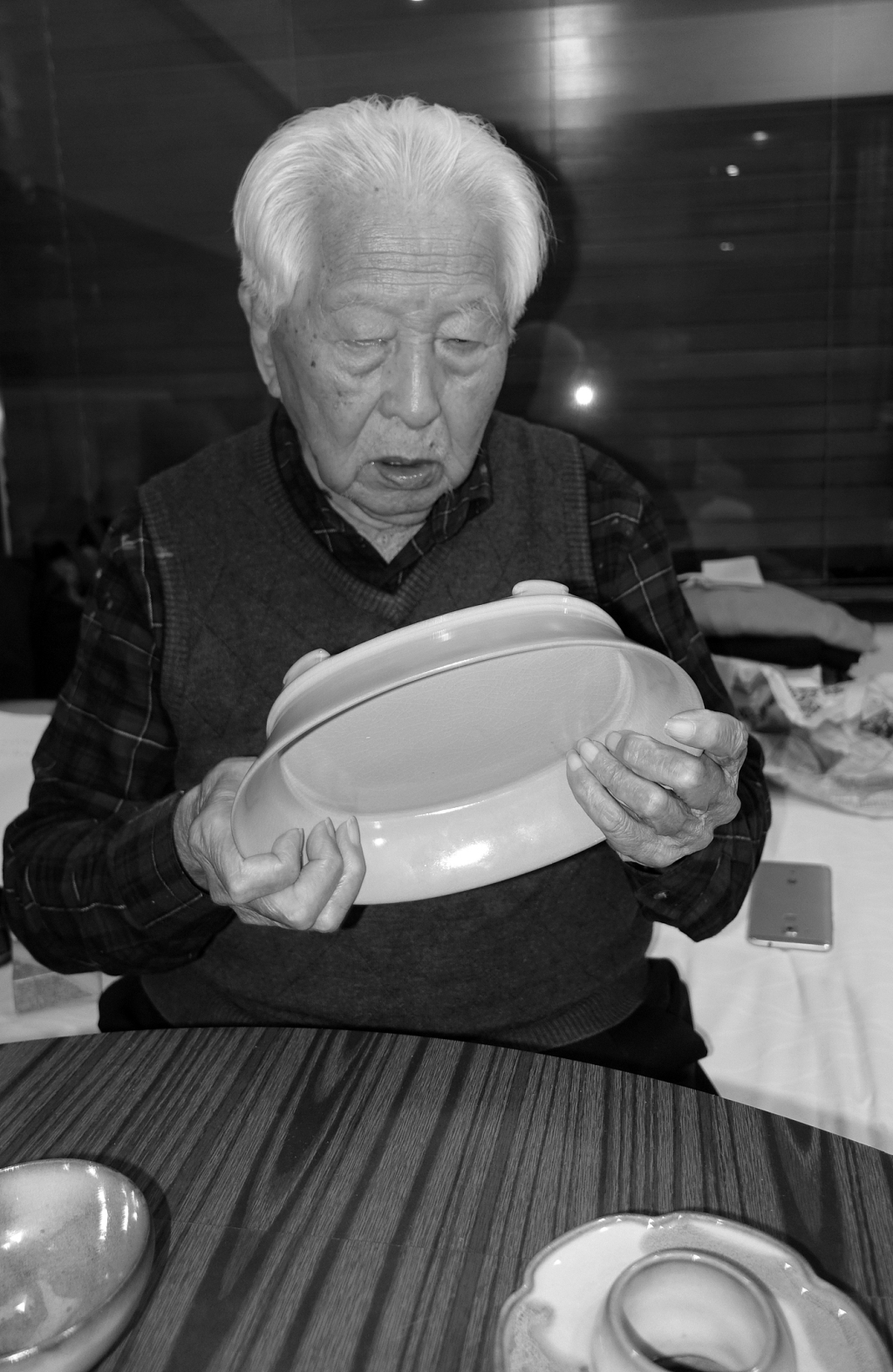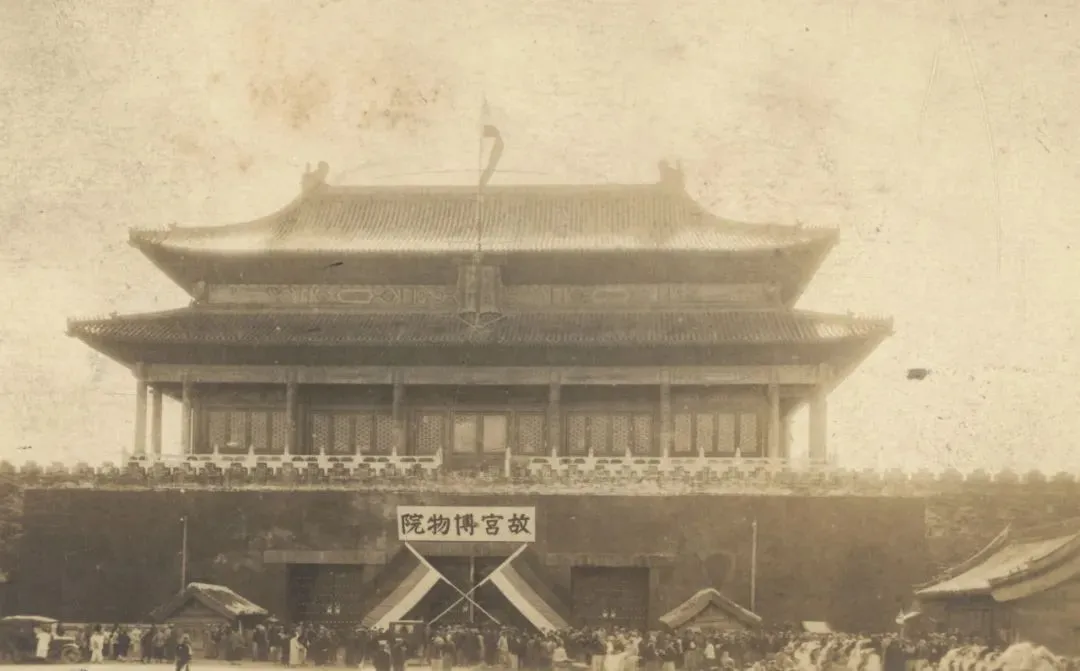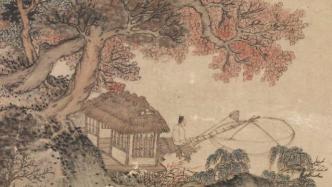
Today is the autumn equinox, the fourth solar term in autumn.
Regarding the autumnal equinox, Yuan Zhen's "A Poem on the Twenty-Four Qi Qi, Mid-August of the Autumnal Equinox" in the Tang Dynasty can be described as a barometer of this solar terms. It is called "Qiushan is bright and clean like makeup". In the famous paintings and calligraphy of the past dynasties, the depiction of autumn scenes includes not only the desolation of reed boats, the frightened flying of reed geese, but also a group of deer swimming and frosted leaves. Yuan Qian selected the title of "Autumn River Waiting to Cross" volume: "The mountains are empty and green and want to flow, and the Yangtze River is soaked in one autumn." In the Qing Dynasty, Wang Hui's "Ten Thousand Layers of Autumn Mountains" axis records: "There are thousands of autumn mountains in the distance, and when I am drunk, I want to pick hibiscus. Where is the peak of the peak, so Danqiu is not easy to meet."
In this season of autumn waters and long days, "The Paper, Ancient Art" specially organizes the "Autumn Mountains" in the paintings of the Forbidden City for readers.
Five Dynasties Southern Tang Juran Qiushan asked the map axis

Five Dynasties Southern Tang Dynasty Juran Qiushan Asking Chart Scroll Collection of the National Palace Museum, Taipei
The landscape painting in the first half of the Northern Song Dynasty took the important position of the domestic painting circle in North China. In the second half of the Northern Song Dynasty, because Mi Fu (1051-1107) highly praised Dong Yuan (about the first half of the tenth century) and Ju Ran (about the second half of the tenth century), the Dong Ju School of Painting in the Jiangnan area gradually received attention. . Juran was a student of Dong Yuan, and the landscapes he painted were clear and smooth, plain and innocent.

Five Dynasties Southern Tang Juran Qiushan Asking Scroll (Part) Collection of the National Palace Museum, Taipei
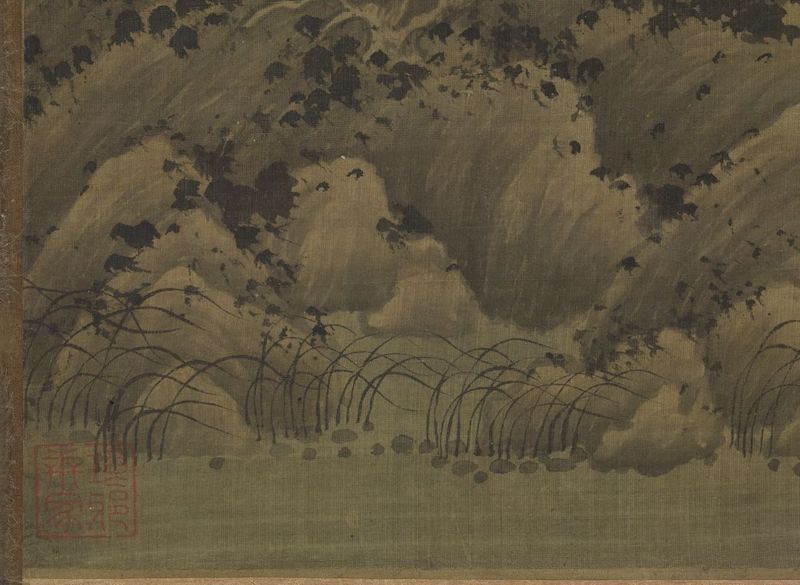
Five Dynasties Southern Tang Juran Qiushan Asking Scroll (Part) Collection of the National Palace Museum, Taipei

Five Dynasties Southern Tang Juran Qiushan Asking Scroll (Part) Collection of the National Palace Museum, Taipei
In this painting, the mountains are stacked in layers, and the mountains are round and do not form steep cliffs. The stone is painted with long arc-shaped lines on the mountain, which is called "Phi Ma Chong". There are still streams and quiet paths in the painting, wind-pulled thatched huts, and a scenery of the south of the Yangtze River. This painting is one of the most important pieces of Juran's works, but the size of the biographical seal "Si Yin" is slightly smaller than that of those who are familiar with it, which leads to doubtful discussions.
Five generations without the autumn forest deer shaft

Five Dynasties Unmarked Autumn Forest Deer Scroll Collection of the National Palace Museum, Taipei
This painting does not have the author's name, but depicts the scene of a group of deer frolicking and resting in the autumn maple forest. The painting method is very strange, which is different from the general traditional method, seems to be influenced by the outside world, and has a strong decorative interest. The deer are all painted with light ink, and the leaves are first painted with fine brush outlines and veins, then dyed with juice green stains, or filled with powder, and then lightly covered with color, the color does not cover the ink, with its own brilliance and floating, and the color of the business is prosperous. . The whole width gives a delicate and soft feeling.
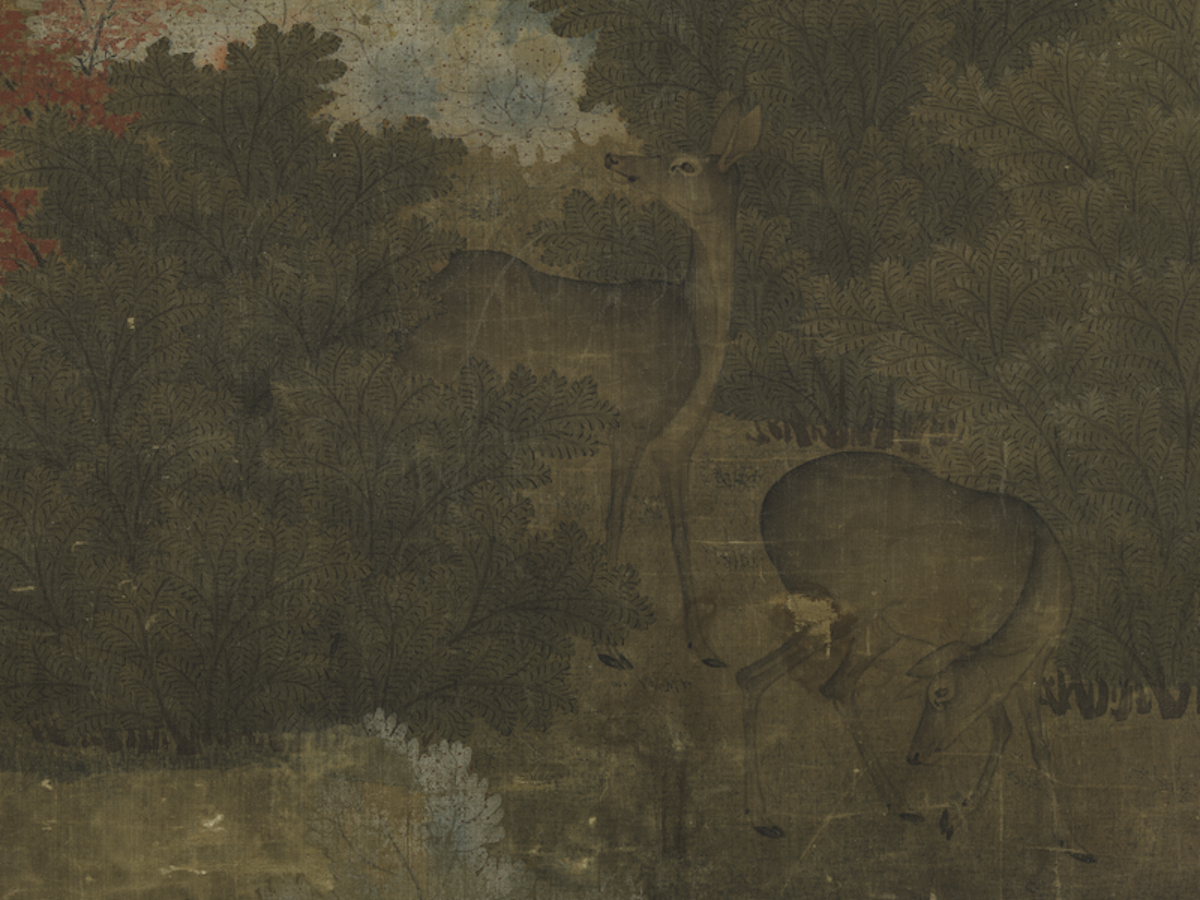
Five Dynasties Unmarked Autumn Forest Deer Scroll (Part) Collection of the National Palace Museum, Taipei

Five Dynasties Unmarked Autumn Forest Deer Scroll (Part) Collection of the National Palace Museum, Taipei
When Renzong of the Song Dynasty was recorded in "Pictures and News", Liao presented a picture of a thousand-horned deer, and this picture may be related to this.
(biography) Five Dynasties Liangguan Tongqiu Mountain Late Green Axis

(Biography) Five Dynasties Liangguan Tong Qiushan Late Green Scroll Collection of the National Palace Museum, Taipei
Wang Duo’s writing inscription: This Guan is the same as the real pen, the writing is deep and steep, the bones are strong, the Guan Sheng is tactful, it is thin and old, and the spirit is majestic. Ni Zan is a first-class person, and he has a shallow habit. As for the two trees, one stone and one beach, he is called "landscape". Li Fan in Jingguan opened the door wide, covering the three poles, but it was not. Ji Chou in October Wang Duo immersed in the Molanghua Pavilion.
The peaks are steep and towering, there are springs and waterfalls, and the scenery is deep and wonderful. The brushstrokes on the rocks and rocks are powerful and the ink color is dignified, showing a thick and firm texture; the leaves are dyed with vermilion and the dead branches are painted to describe the autumn time.

(biography) Five Dynasties Liangguan Tongqiu Mountain Late Green Scroll (Part) Collection of the National Palace Museum, Taipei
From the composition point of view, the two sides of the frame are very urgent, as if they were once cut out. This anonymous inscription, now named Guan Tong, is based on Wang Duo's postscript in the sixth year of Shunzhi (1649). Wang Duo thinks that this painting is deep in structure, and the brushwork is old and majestic. In fact, there are no reliable Guantong paintings to compare with in the handed down works, so it remains to be researched whether this painting was made by Guantong. In terms of style and expression techniques, it is slightly similar to Yan Wengui (about 967-1044), and the era of painting may be placed in the middle of the Northern Song Dynasty (about 1040). Guan Tong (mid tenth century), a native of Chang'an, Shaanxi. The landscapes in the Shaanxi (Shaanxi Province) area are so impressive that the history of painting commented on his paintings: "The simpler the brush, the stronger the air; the fewer the scenes, the longer the meaning."
Song Zhao Boju's pictures of autumn colors in the mountains and rivers

Song Zhao Boju's Autumn Colors of Jiangshan and Mountains, Collection of the Palace Museum
This scroll has seals such as "Treasure of Qianlong Imperial View" and "Shiqu Baoji" of the Qing Dynasty, as well as the seals of Liang Qingbiao's collection. The end paper has a postscript with the title of Zhu in the eighth year of Ming Hongwu (1375).
This image is painted in turquoise. In the painting, there are green mountains and clear waters, temples and cottages, plank roads and bridges interspersed among them, as well as green pines and cypresses, thick forests and bamboos, and the scenery changes every step of the way, which makes people ponder. The rocks are cleaved with a small axe, and then heavily colored with green and green; The entire work has a grand layout, rich details, rich colors without losing elegance, and detailed but not trivial depictions, with the style of the Song Dynasty painting academy.
Song Guoxi's stone flat and far map axis

Song Guoxi's Pingyuan Map Scroll Collection of the Palace Museum
Close-up of the picture, the stream is clear and shallow, the rocks on the shore are bare, there are a clump of trees on the rocks, the branches are crooked, some leaves are completely fallen, and some old leaves are painted, which are rendered with light ink. In the distance, the cold smoke is green, the wasteland is vast, the mountains are lined up like a barrier, and the sky is clear and dust-free, which is a scene of late autumn.
In Guo Xi's theory of landscape painting, he advocates that in-depth observation and experience of real mountains and waters is a prerequisite for creation. When going deep into the actual experience, he adopts the comparative observation method. The "Pingyuan Map of Shek Stone" depicts the late autumn in the north. From the comparative observation, he realized that "the mountains in the northwest are rich and thick", "the mountains are many piles of hills, and they are continuous and continuous, thousands of miles away. " The stone and distant mountains in the painting reflect these characteristics. Guo Xi's creation is Guo Xi's creation of the husks, which use the method of cirrus clouds to express the richness and depth of the landscape in the north. In autumn, his feelings are "Qiushan is bright and clean like makeup", "Qiushan is bright and clean and swaying and people are solemn". There is no bleak and sadness in the painting. Pure beauty. In particular, the tortuous stream water is clear and fresh, not irritating or angry, clear and shallow, and it is connected with the Lili stone, giving people the feeling of "getting to the bottom". This late autumn scene is full of charm, which is difficult for ordinary painters to perceive and express.
Guo Xi first summed up the "three distances" rule of framing and composition in Chinese landscape painting. "Three distances" means high distance, far-reaching and peaceful distance. The "Pingyuan Map" indicates that the "Pingyuan" method is adopted. Guo Xi explained: "From the nearby mountains to the distant mountains, it is called Pingyuan". Framing the scene in the painting, the eye level is about one third of the lower part, and the scene is concentrated in the horizontal view. Looking from the foreground to the long shot through the middle shot, the layers are distinct, showing the depth of the space distance. Although the picture is not much inked, the realm is vast and the momentum is majestic, which inspires people to watch the spirit.
There are not many works of Guo Xi that can be seen today, and only six or seven works are truly credible. "Pingyuan Picture of a Pile of Stones" is one of the pictures with the year mark. It was created in Wuwu (1078), the first year of Yuanfeng. work.
(biography) Song Guoxi's trip to the mountains
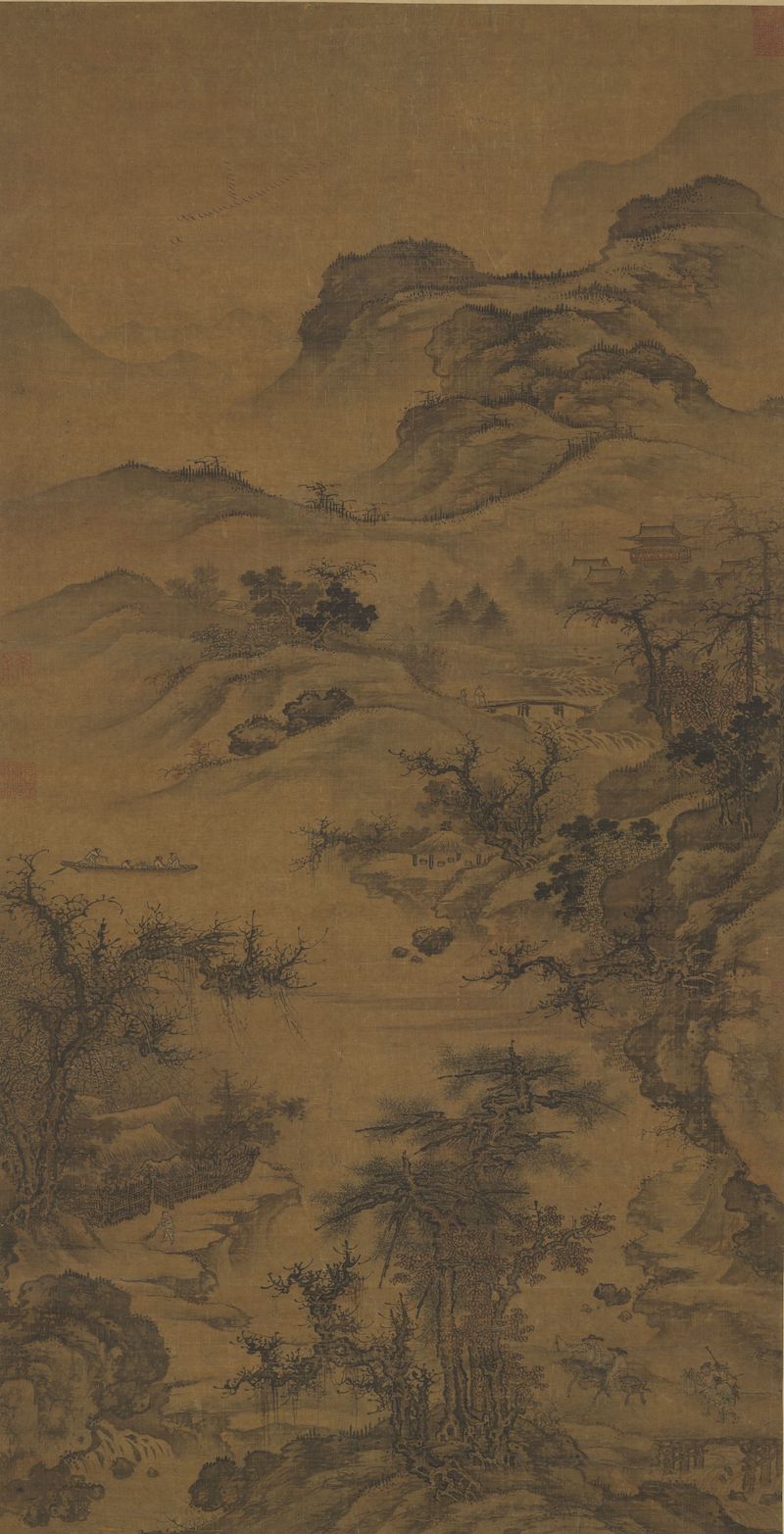
(Biography) Song Guo Xiqiu Mountain Travel Chart Scroll Collection of the National Palace Museum, Taipei
The hills are ups and downs, the rivers are meandering, and ancient temples and cottages are scattered among them. Some trees have withered away, and the autumn is already strong. "Guo Xi" is inscribed between the stone crevices on the lower left. Although the posture of the sturdy giant pine and the dead branches painted with crab claw brushes in this painting all have the same breath as Guo Xi (active in the second half of the 11th century), the famous work "Early Spring", but it does not see the "Early Spring". It presents the majestic momentum of the main mountain, and the artistic conception of landscapes that can be visited and lived; and the composition and layout of this painting, the use of brush and ink are far from it, and it should be regarded as the work of later generations.

(Biography) Scroll of Song Guoxi's Journey to the Mountains (Part) Collection of the National Palace Museum, Taipei
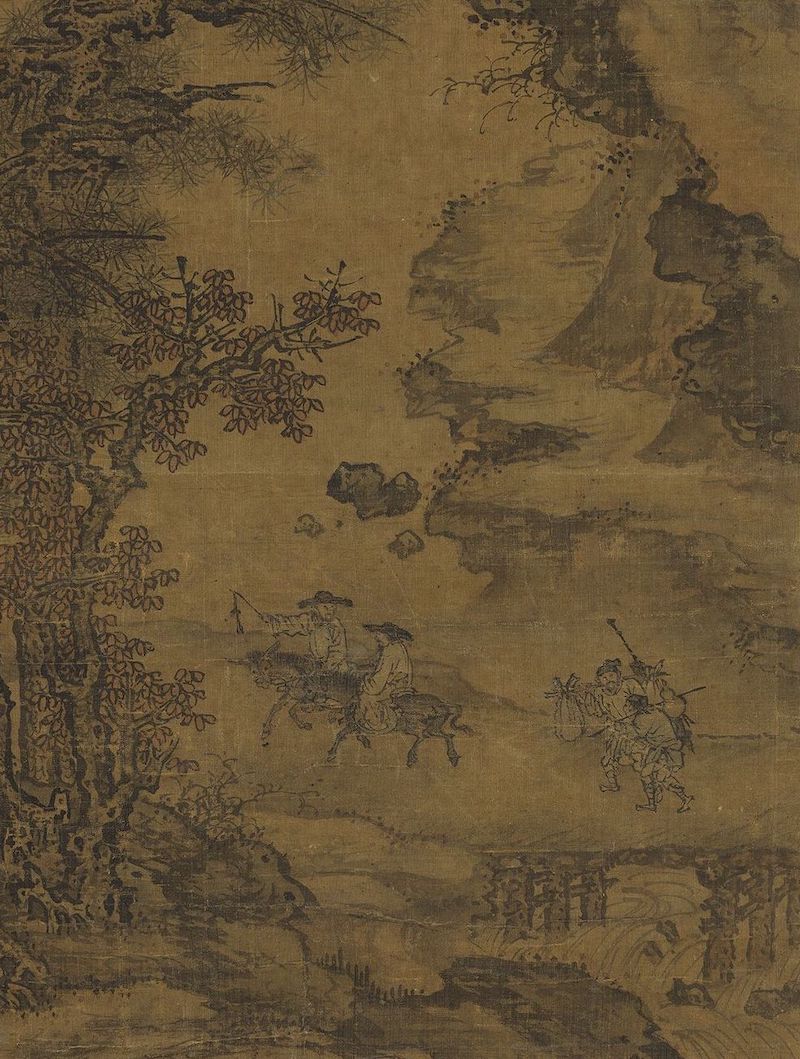
(Biography) Scroll of Song Guoxi's Journey to the Mountains (Part) Collection of the National Palace Museum, Taipei
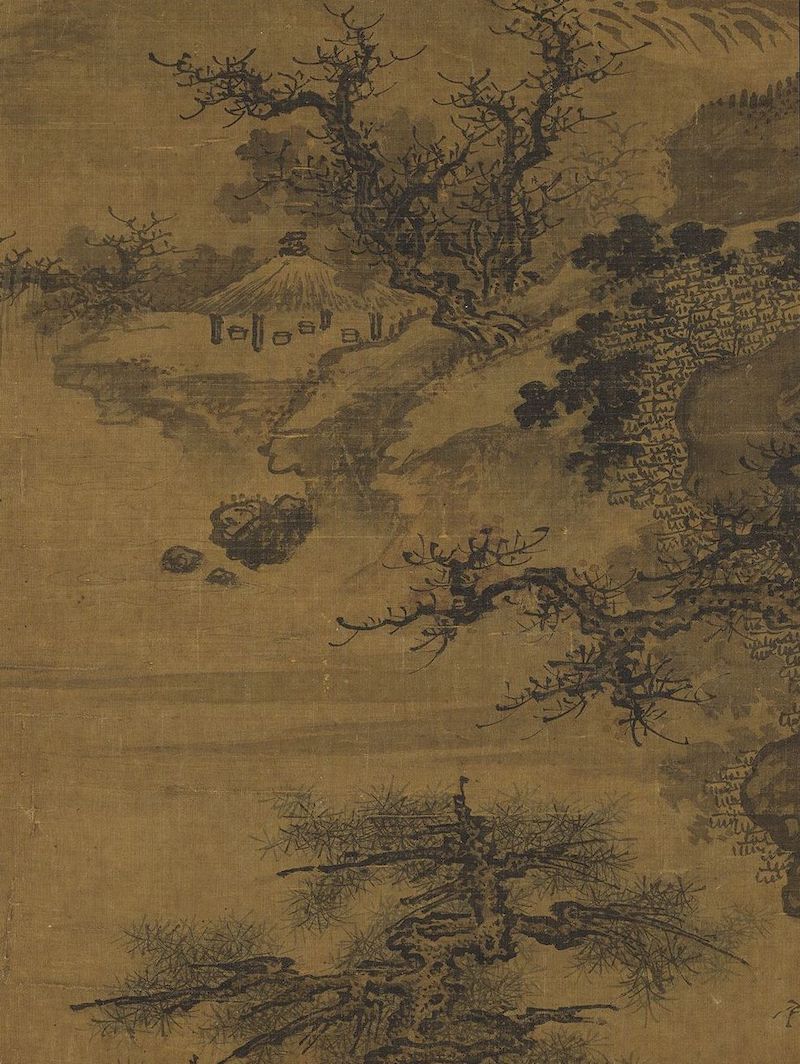
(Biography) Scroll of Song Guoxi's Journey to the Mountains (Part) Collection of the National Palace Museum, Taipei
(Biography) Song Huizong's Autumn Color Chart of Xishan Mountains
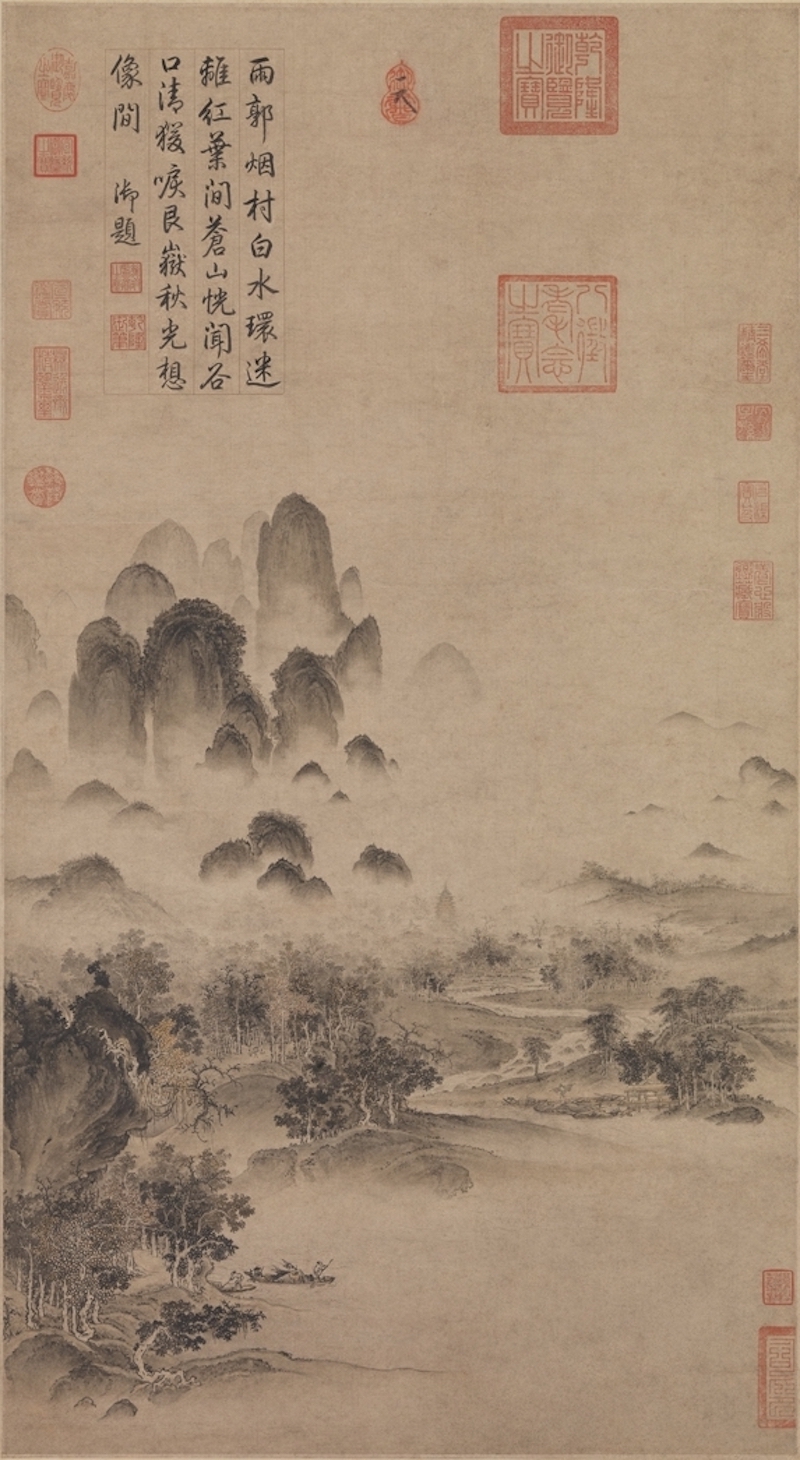
(Biography) Song Huizong Xishan Autumn Color Chart Scroll Collection of the National Palace Museum, Taipei
Huizong Zhao Ji (1082-1135), the eighth emperor of the Northern Song Dynasty, was good at painting flowers and birds, and was also good at poetry and calligraphy. During his tenure, he reformed the Painting Academy, edited books such as "Xuanhe Books", "Xuanhe Paintings" and "Xuanhe Bogu Lu", creating an example of collection description. In the painting, the mountains and mountains and the trees on the sandy slopes appear on the upper left side of the painting. The outlines of the mountains and rocks are round, and the ink washes and washes lightly dye them.

(Biography) Song Huizong's Autumn Scroll (Partial) Collection of the National Palace Museum, Taipei

(Biography) Song Huizong's Autumn Scroll (Partial) Collection of the National Palace Museum, Taipei
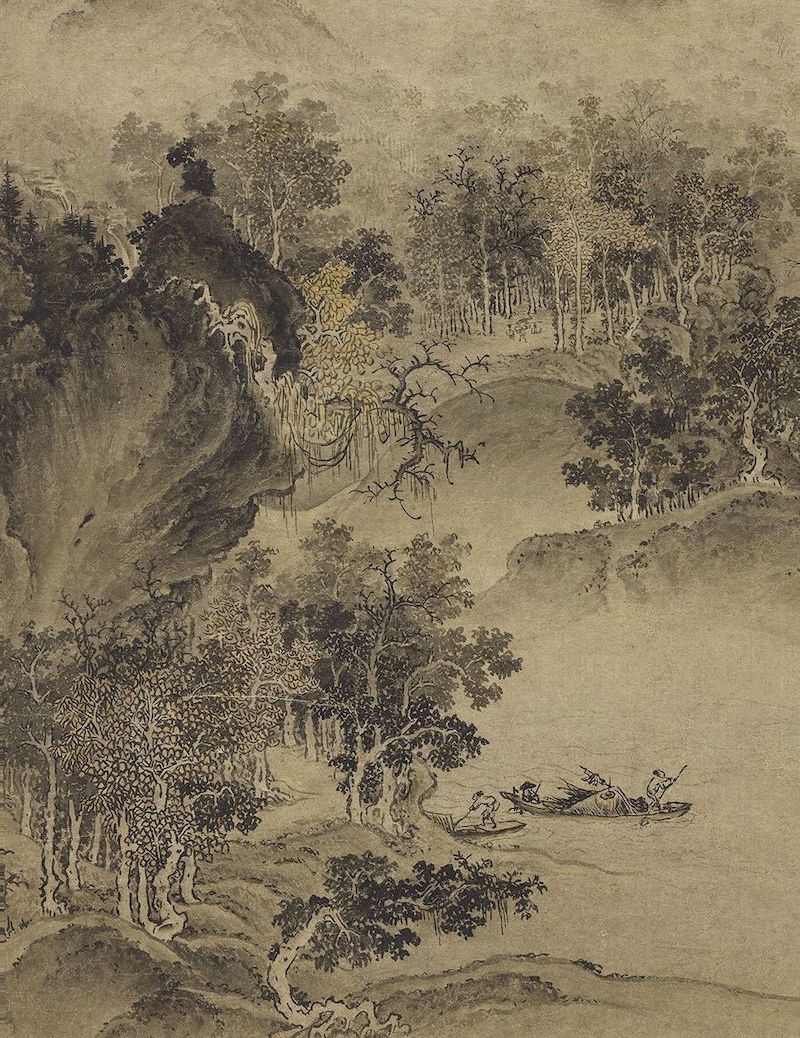
(Biography) Song Huizong's Autumn Scroll (Partial) Collection of the National Palace Museum, Taipei

(Biography) Song Huizong's Autumn Scroll (Partial) Collection of the National Palace Museum, Taipei
Although the seal has Huizong's monogram and the imprint of "Yu Shu", from the style of the painting, the painting was completed around the Southern Song Dynasty.
The Four Landscapes of the Song Dynasty in the Year of Liu Song

Song Liu Songnian Four Landscapes Landscape Scroll Collection of the Palace Museum
This scroll is divided into four sections, depicting the four seasons of spring, summer, autumn and winter respectively. The third picture is selected for this picture, which is a view of the mountains, the autumn is high and the air is cool, and the frost and leaves are dyed.
The picture is centered on the activities of characters, combined with boundary painting techniques, and carefully constructed courtyards, terraces and other buildings, neat and exquisite, or rich, or simple. The mountains and rocks are cut with a small axe, and they are vigorous and vigorous. The brushwork and colors are rigorous and pay attention to the law. Although the characters in the painting are small, they are complete in form and spirit. The whole work has a simple appearance and strict brushwork, which is very characteristic of the works of the Southern Song Dynasty Painting Academy. Lin'an (present-day Hangzhou, Zhejiang) was the capital of the Southern Song Dynasty, and there were many garden villas for high-ranking officials and dignitaries. This picture is intended to express the leisurely life of the gentry and bureaucracy. The painter's attention has shifted from the natural rhythm of mountains and rivers to the artificially created and decorated scenery. This change in the theme and style reflects from the side a large number of unintentional restoration of the country during the Southern Song Dynasty. Bureaucrats, a hedonistic attitude to life. As the poem goes: "The warm wind makes tourists drunk, making Hangzhou a Bianzhou" .
(Biography) Song Yanwengui Qiushan Linyu Chart Scroll

(Biography) Song Yanwengui Qiushan Linyu Chart Scroll Collection of the Palace Museum, Taipei
In this painting, there are many mountain peaks, and the mist lingers in the valley, which seems to describe the beginning of the rain. The ravines are rushing down, and the path is winding, extending to the pavilions in the mountains, and the scenery is quiet and elegant.
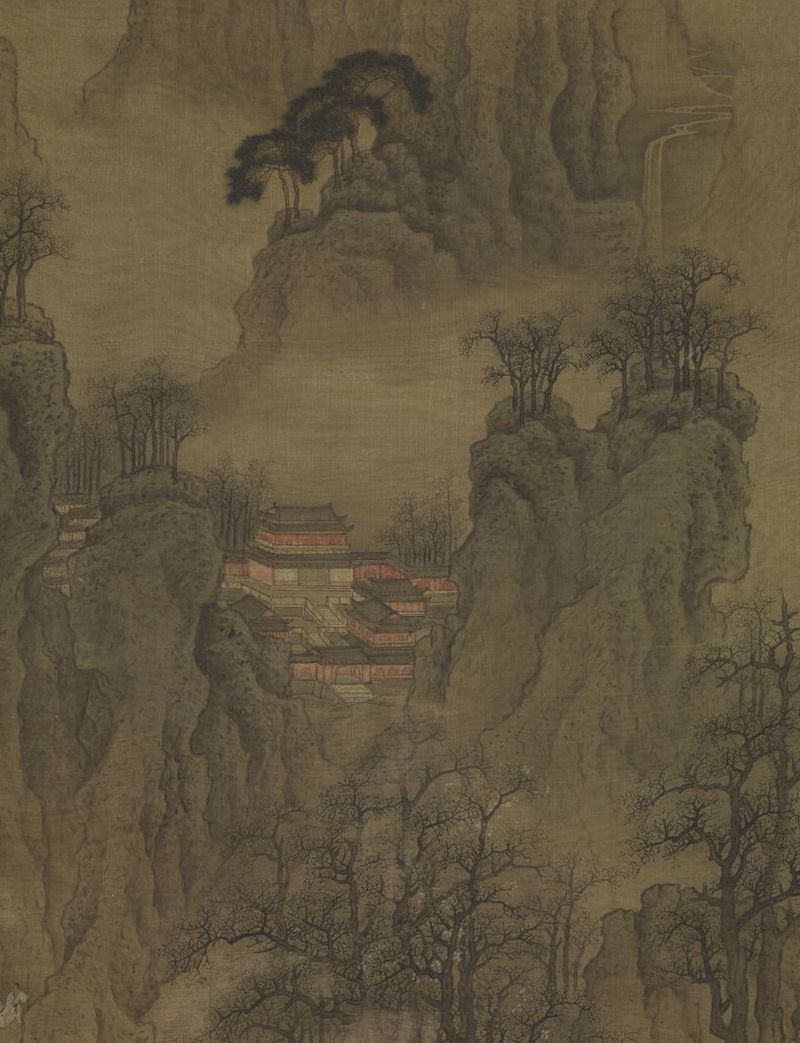
(biography) Song Yanwengui, Qiushan Linyu Scroll (Partial) Collection of the National Palace Museum, Taipei

(biography) Song Yanwengui, Qiushan Linyu Scroll (Partial) Collection of the National Palace Museum, Taipei
Although the style of this painting is of Yan Wengui, the style of painting is similar to that of the late Ming Dynasty. Yan Wengui (about the eleventh century AD) was born in Wuxing, Zhejiang. When he was young, he lived in the capital (Kaifeng, Henan) as a trader. Later, his talent was appreciated by Gao Yi, the imperial edict of the Painting Academy. The landscape and characters are all good, especially good at depicting the four seasons, elegant and lovely. People in the painting academy call his painting "Yanjiajing".
Song Dynasty Autumn Mountain Chart Scroll

Song Dynasty Autumn Mountain Scroll Collection of the National Palace Museum, Taipei
The mountains extend upwards from the bottom of the picture frame, and are stacked full of paper. Among the complex and rich mountains and rocks, the rivers flow through them to form changes in the hills and valleys, and get the interest of combining reality and reality.
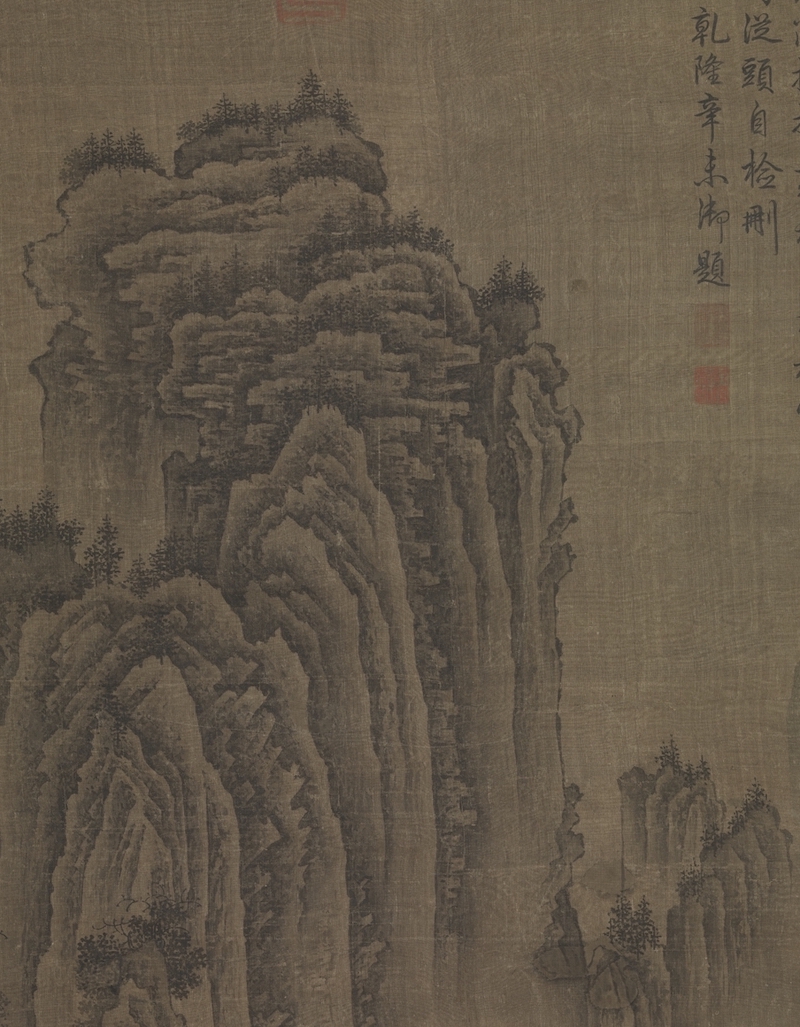
Song Dynasty Autumn Mountain Scroll (Part) Collection of the National Palace Museum, Taipei
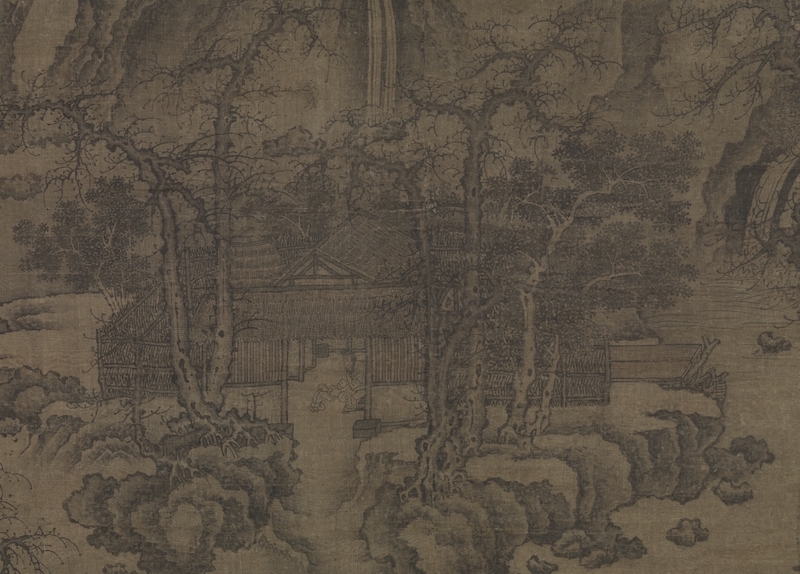
Song Dynasty Autumn Mountain Scroll (Part) Collection of the National Palace Museum, Taipei
This painting is similar to Fan Kuan's raindrops, and the dead branches of the cold forest are similar to Guo Xi's crab claw, and the whole painting style is very similar to "Jing Hao Kuanglu".
(Biography) Song Li Xiangdong Li Autumn Color Chart Axis
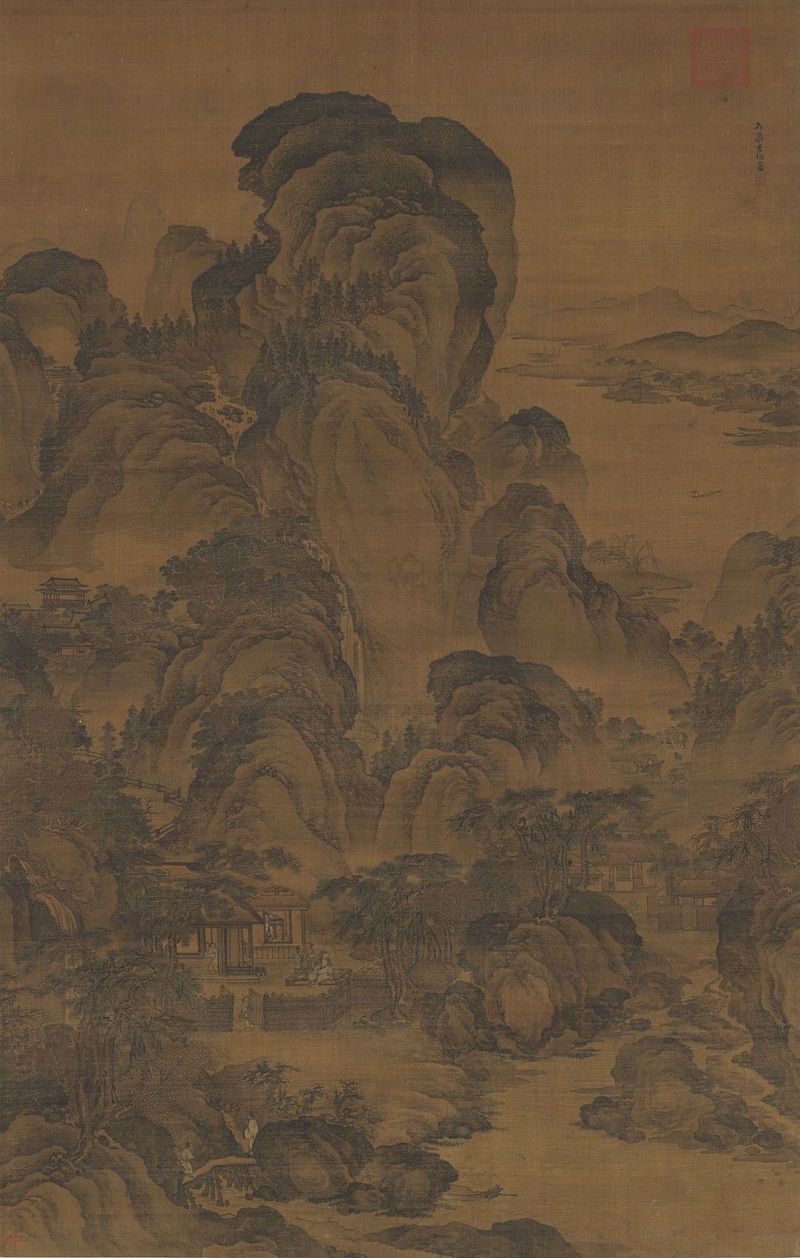
(Biography) Song Li Xiangdongli Autumn Color Chart Scroll Collection of the National Palace Museum, Taipei
In the deep forest with folded peaks, there is a waterfall in the center, meandering down, the river bridges in the vicinity pass by, and the Liuting on the Qingjiang River in the distance is paddling by a small boat. Shepherd boys and cows walk along the trails. There are two cottages beside the stream, Tao Yuanming is sitting on the couch enjoying the chrysanthemum. There are not many gaps in the layout, and the Leilei giant rock can be seen everywhere, and its momentum is its characteristic. The shape of the long pine and the outline of the boulder are obviously influenced by the painting styles of Li Cheng and Guo Xi. This painting was painted by Li Xiang of Song Dynasty. But the trivialities are not like the Song people. Li Xiang, alias Shiquan master, Wuxi layman. Life is pending.
Yuan Qian selects the picture of the Autumn River to be crossed

Yuan Qian selects the picture scroll of the Autumn River to be crossed in the Palace Museum
Quoting the four characters "Qiujiang waiting to be crossed" in the Qianlong imperial inscription, with the seal "Yu Shu" (Zhu Wen), this piece has a five-character rhythm poem inscribed in Qianlong's running script, and the back paper has Chen Gong, Hu Weiren, Zhu Yong, Hu Dun, etc. 17 inscriptions or poems. He once wrote "Shigutang Calligraphy and Painting Collection Examination", "Grand View Record", "Jiangcun Sales Summer Record", "Jiangcun Calligraphy and Painting Catalog", "Moyuan Collection View", "Shiqu Baoji Sequel: Mental Cultivation Hall" and so on. There are nearly 80 squares of seals in the collection of Gao Shiqi, An Qi, Qing Neifu, etc.
This picture depicts the scenery of lakes and mountains in the south of the Yangtze River. The first one is a thatched hut, surrounded by luxuriant trees. The water waves in front of the house are unhappy, the peaks behind the house are towering, and the mist is light in the distance. The atmosphere is quiet and peaceful, like a fairyland of a mountain. In the center of the picture is a large expanse of open water, the river is vast, and the distant autumn mountains are faint and undulating. There are green and red trees on the soil slope on the left bank of the river, one person is waiting to cross, the autumn water sees through, and the passenger ship that is about to cross him has just left the other side. At the back of the volume, there is a self-titled seven-character quatrain: "The mountains are empty and green and want to flow, and the Yangtze River soaks through a day of autumn. Outside the sunset and the cold smoke at the Maoci, there are long standing pedestrians waiting to cross the boat." This volume adopts a combination of poetry, calligraphy and painting. He enriched his paintings with poetry and created a new style of painting in the Yuan Dynasty.
The outlines of mountains, rocks, forests and trees are outlined with ink lines, and then heavy colors of green and green are applied. The painting method is close to Zhan Ziqian's "Spring Tour", which obviously has a "retro" charm and a vast artistic conception.
Yuan Gao Kegong Qunfeng Autumn Color Axis
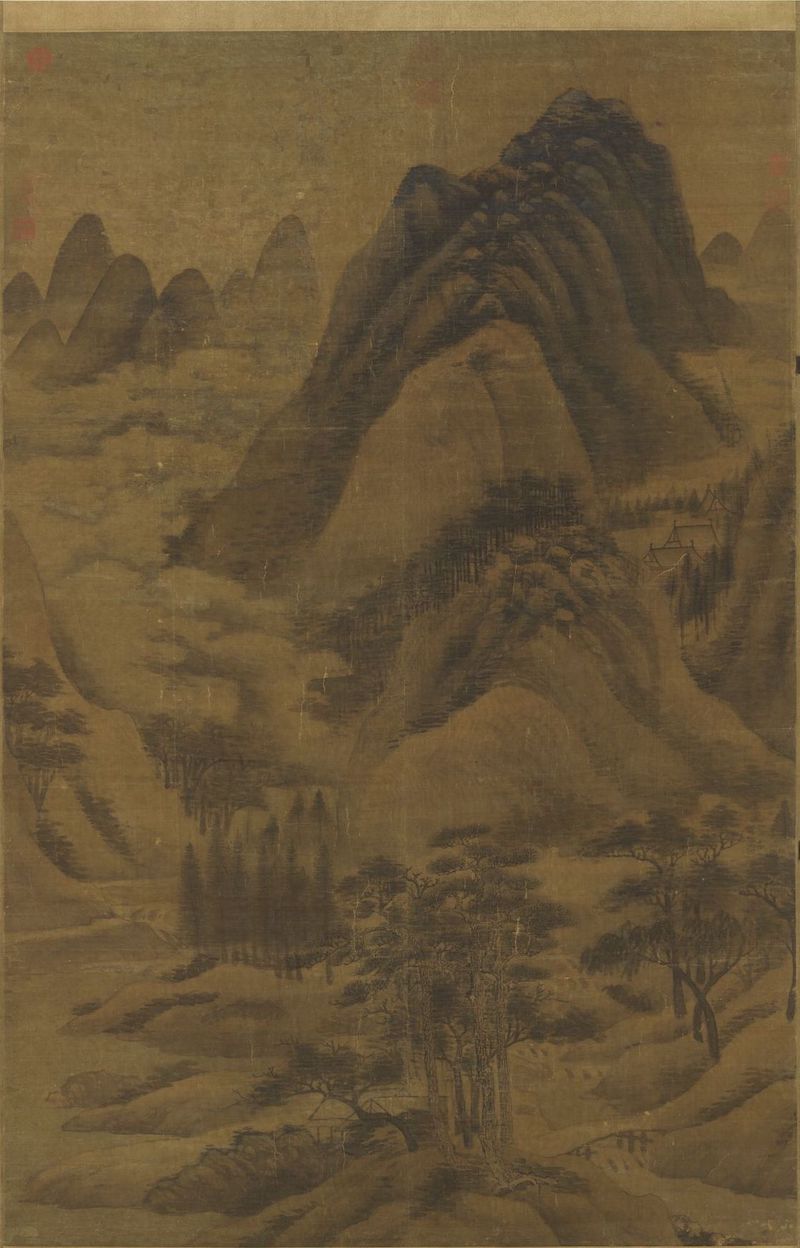
Yuan Gao Kegong Qunfeng Autumn Color Axis Collection of the Palace Museum, Taipei
Gao Kegong (1248-1310), originally from the Western Regions, later moved to Yanjing. The word Yanjing, the old man of Fangshan.

Yuan Gao Kegong Qunfeng Autumn Color Scroll (detail) Collection of the National Palace Museum, Taipei
The peaks and peaks in the painting are mostly dyed with light ink and light color, the main peak is the heaviest ink, and the top of the mountain is decorated with horizontal brush "rice dots", which has the interest of dripping ink. The stains of stone green and azurite are thick and elegant, making the peaks more vigorous and stable.
Yuan Tao Fu's Early Paintings of Autumn Forest Small Hidden Scroll
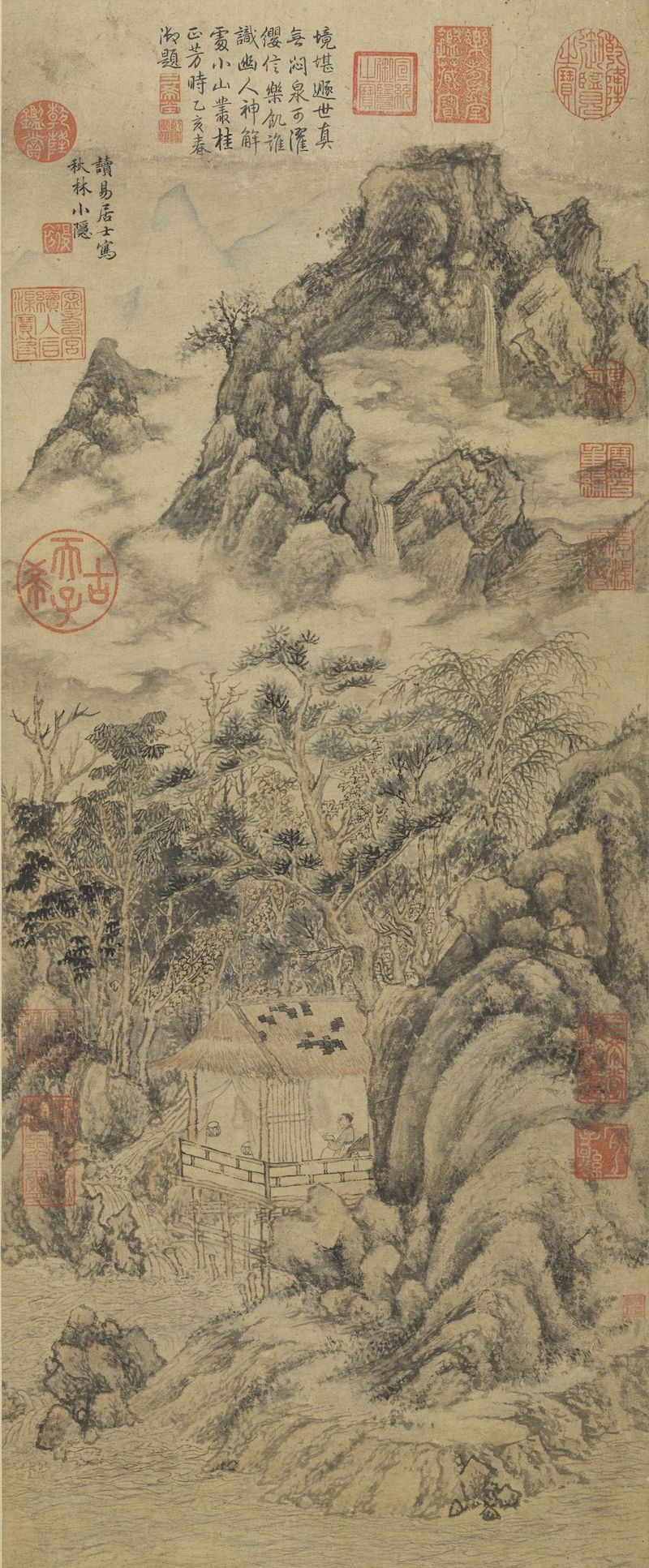
Yuan Tao Fu's early painting Autumn Forest Small Hidden Scroll Collection of the National Palace Museum, Taipei
Tao Fuchu, a native of Tiantai in the early Yuan Dynasty. The name is Mingben, and the number is Jiexuan. Li Xizhai, a calligrapher and bamboo master, and his son, who are calligraphers and bamboo masters, are very good at coloring bamboo, and they are also capable of landscapes. Tao Fu was a famous painter of bamboo at the beginning, but there are very few handed down works.

Yuan Tao Fu's Early Paintings of Autumn Forest Small Hidden Scroll (detail) Collection of the National Palace Museum, Taipei
In this frame, there is a crevice in the crevice of the riverside, with a water thatched cottage, miscellaneous trees and clouds, surrounded by mountains on the back. The brush and ink are extremely elegant, and the house still has the aftertaste of the Song Dynasty. The gushing water lingered, and the ripples were turbulent. The brush and ink are very fine, but the top is pressed against a peak, the brush is crumpled, and the micro-feeling is fine.
Yuan Wuzhen Qiujiang fishing hidden axis
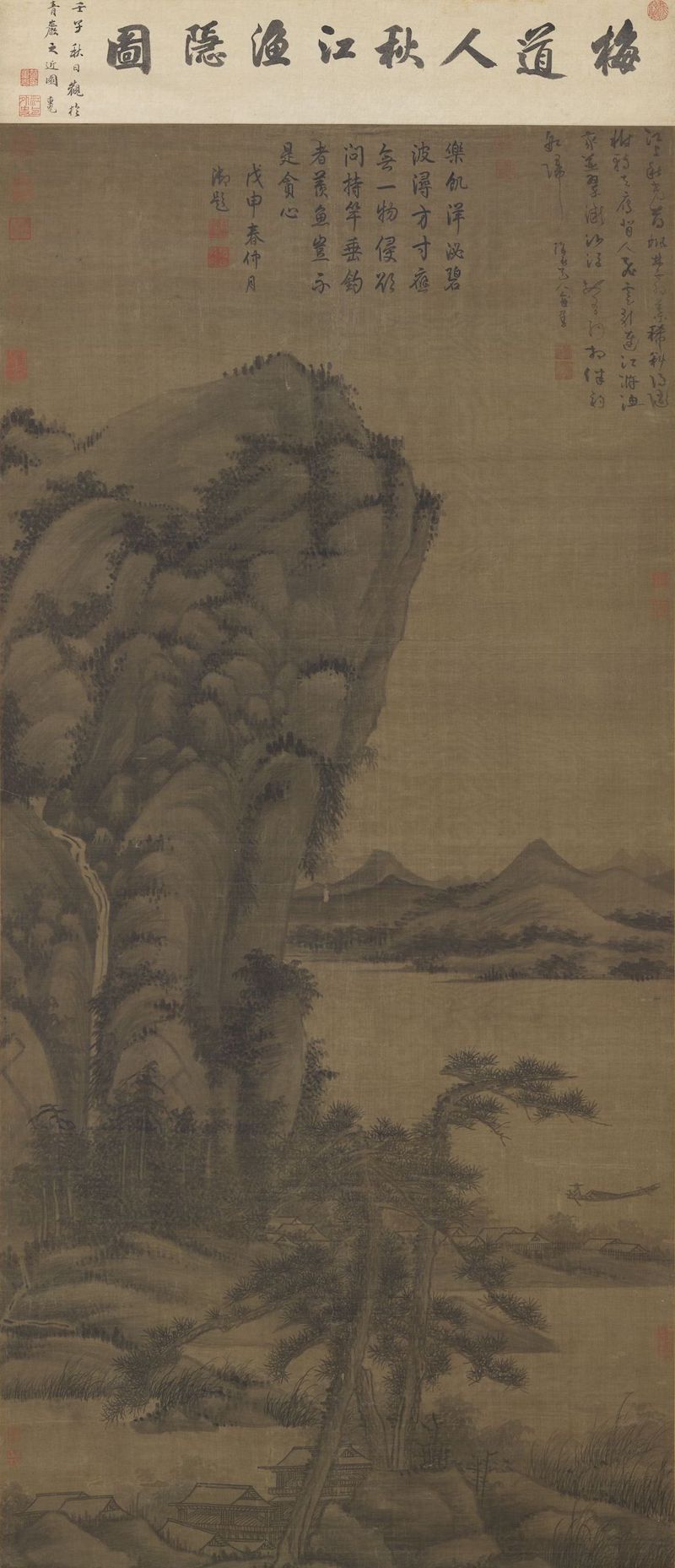
Yuan Wuzhen Qiujiang Fishing Axis Collection of the Palace Museum, Taipei
Wu Zhen (1280-1354), whose courtesy name was Zhonggui, was a native of Jiaxing, Zhejiang. His landscape study of the Five Dynasties Juran, and Mozhu's study of Song Dynasty Wentong, can all integrate the strengths of their predecessors and create their own style of painting.
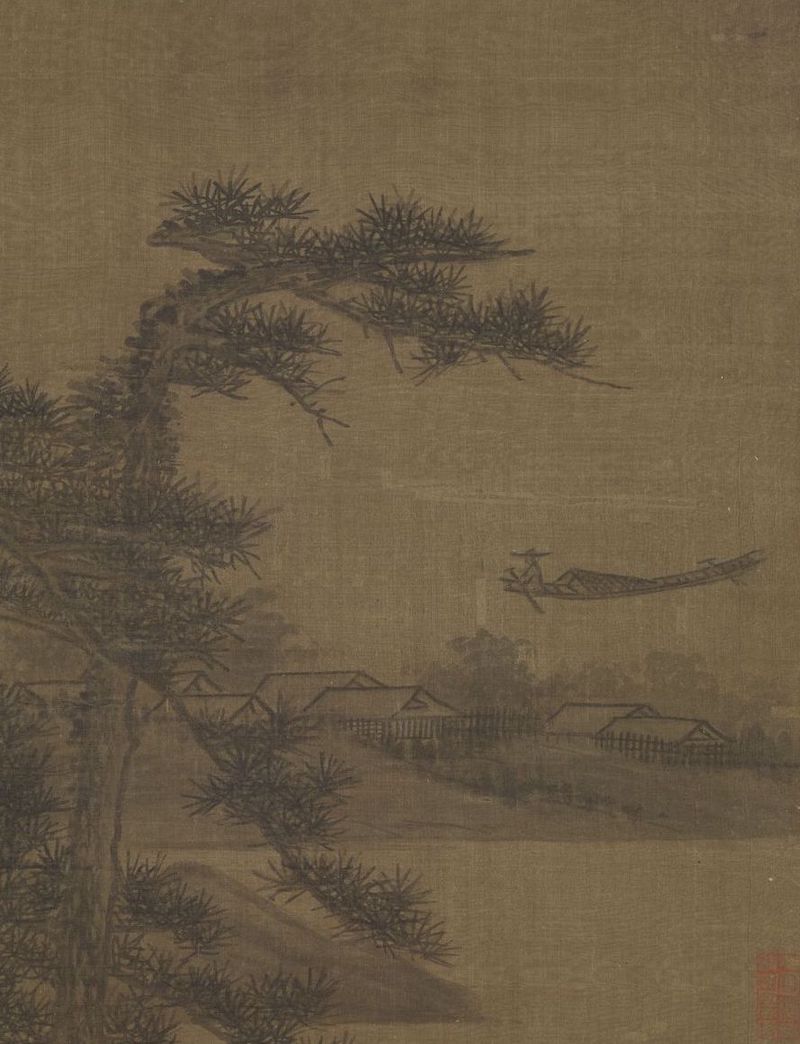
Yuan Wuzhen Qiujiang Fishing and Hidden Axis (detail) Collection of the National Palace Museum, Taipei
The painting depicts a waterfall cascading down a towering cliff. Among the rocks on the slope of the cangshu, there are village houses and people. In the distance is an empty river and mountains, only a small fishing boat is floating in the middle of the river. The whole painting is mostly painted with a center-front bald brush. The brushwork is calm and powerful, and the stains are thick. With the majestic cliffs and the tall pine trees, it feels even more majestic and heavy.
Yuan Ni Zan Wanhe Autumn Pavilion Axis

Yuan Ni Zan Wanhe Autumn Pavilion Scroll Collection of the Palace Museum, Taipei

Yuan Ni Zan Wanhe Autumn Pavilion Scroll (detail) Collection of the National Palace Museum, Taipei

Yuan Ni Zan Wanhe Autumn Pavilion Scroll (detail) Collection of the National Palace Museum, Taipei

Yuan Ni Zan Wanhe Autumn Pavilion Scroll (detail) Collection of the National Palace Museum, Taipei
Yuan Wang Mengqiu Mountain Thatched Cottage Scroll
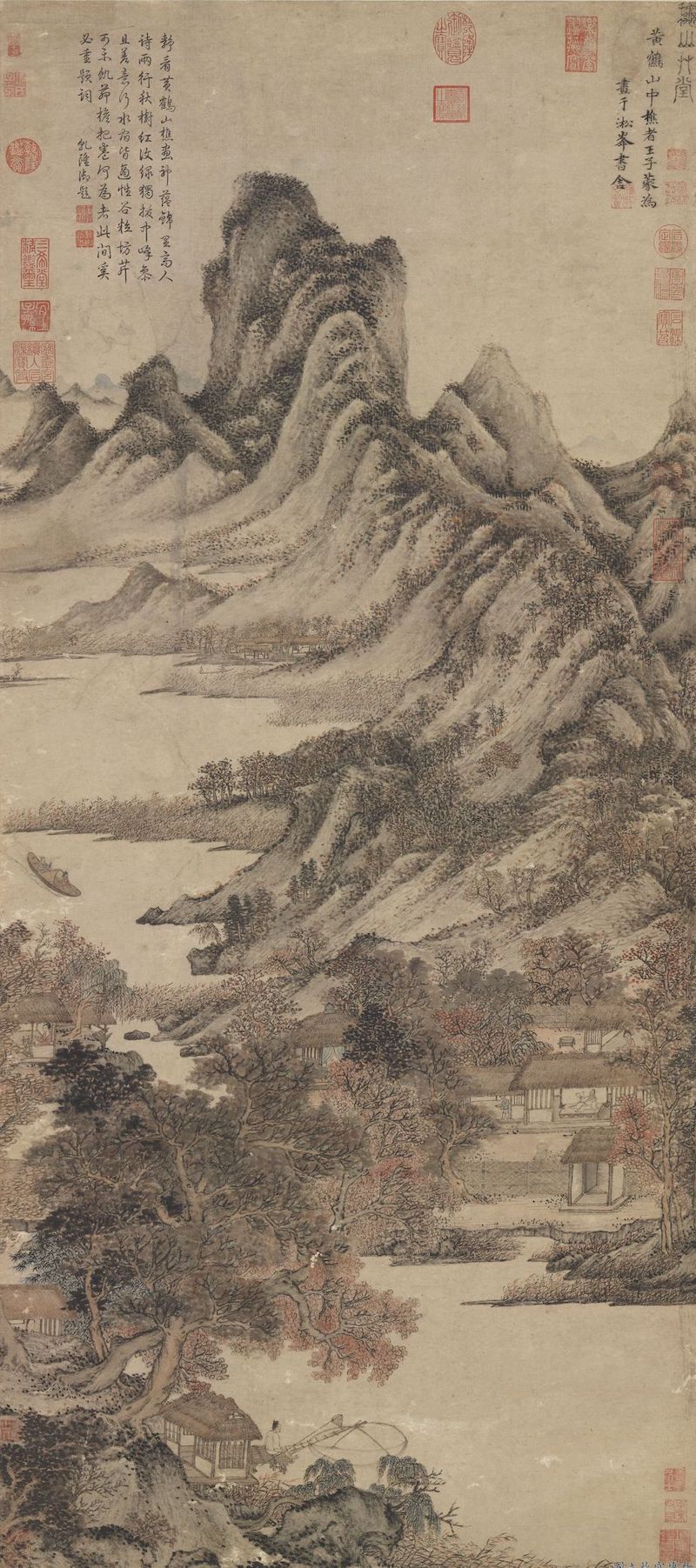
Yuan Wang Mengqiu Mountain Thatched Cottage Scroll Collection of the National Palace Museum, Taipei
Wang Meng (1301-1385) was born in Wuxing, Zhejiang. The word Shuming, the number of Xiangguang layman, Huangheshanqiao. Zhao Mengfu's grandson, who painted Zhao's method and was able to stand on his own, was good at painting, and wrote long poems. He was one of the four great masters of the Yuan Dynasty.
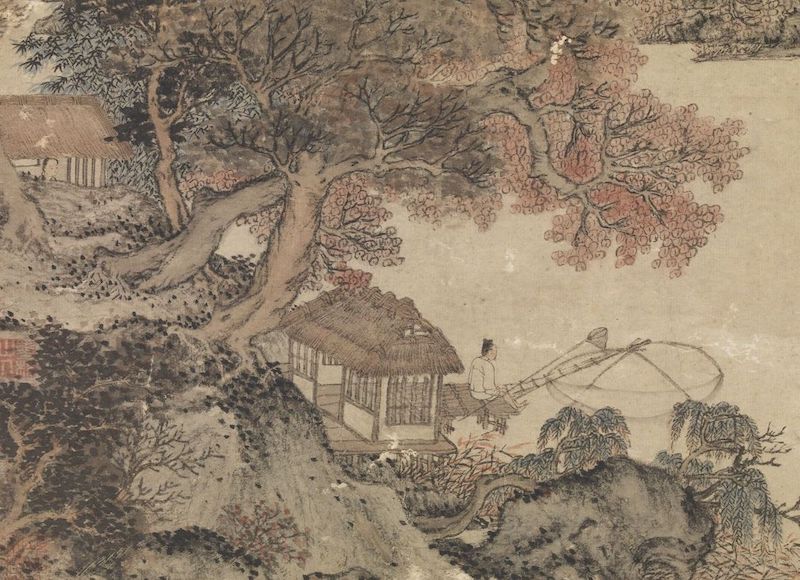
Yuan Wang Mengqiu Mountain Thatched Cottage Scroll (Part) Collection of the National Palace Museum, Taipei
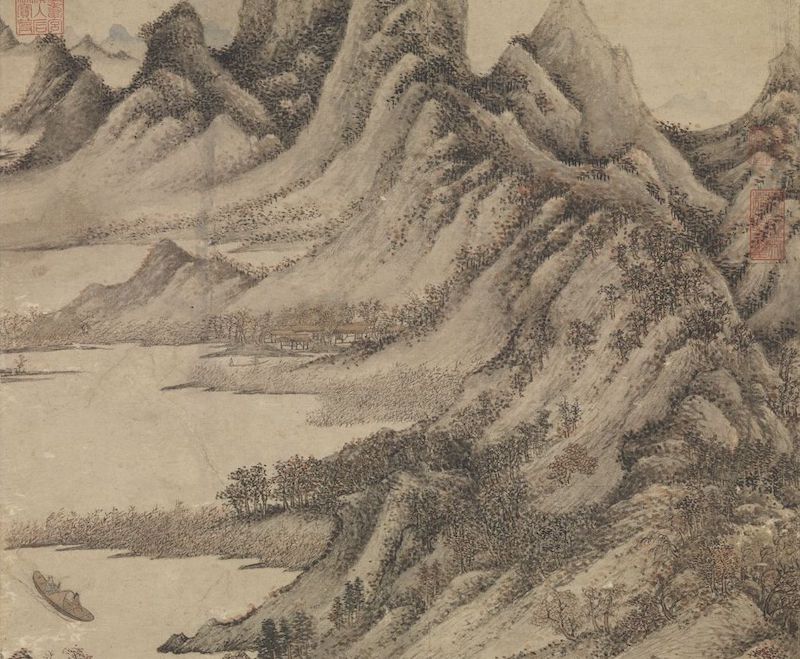
Yuan Wang Mengqiu Mountain Thatched Cottage Scroll (Part) Collection of the National Palace Museum, Taipei
In this picture, on both sides of the river, the trees are staggered, and the distance between them is very beautiful. The houses in the woods are linked together, and the men and women work and rest. Although they do not seek similarities in appearance, they have a refreshing atmosphere of the mountains and forests, which cannot be achieved by those who describe them in a cut way. The back mountain stretches far away, and there are wild boats and sparse forest huts, which are really endless. The brush and ink are elegant and light throughout, and the coloring is very fine. In the quietness, I feel that it is ancient and thick and clear.
Scroll of Yuan Wang Mengqiu Shanxiao Temple

Yuan Wang Mengqiu Shanxiao Temple Chart Scroll Collection of the National Palace Museum, Taipei
In the 22nd year of Zhizheng (1362), Wang Meng painted this painting in Zou Fulei's Pengdiju residence. The ink color in the painting varies from light to dark, and there are many places where coke ink is used. The brushwork of the chapped pattern is very complicated, but not disordered, and it can especially express the feeling of dense and lush mountains and forests.
Yuan Wang Mengqiu Lin Wanhe map axis

Yuan Wang Mengqiu Lin Wanhe Chart Scroll Collection of the National Palace Museum, Taipei
This picture depicts a river on both sides of the river, and the trees are staggered. The back mountain stretches far away, and the houses in the forest are connected to each other, and there is a refreshing atmosphere of the mountains and forests.

Yuan Wang Mengqiu Lin Wanhe Chart Scroll (Part) Collection of the National Palace Museum, Taipei
The brush and ink are elegant and light in color throughout, and in the quietness, I feel that it is ancient and thick and clear. At the bottom right of the picture, there is the number 482 "Gao" in the thousand-character text, which was originally collected by Xiang Yuanbian.
Yuan Zhu Deruns the Autumn Stream in the Smoke and Lanterns

Yuan Zhu Derun's Autumn Stream Scroll, Collection of the National Palace Museum, Taipei
Zhu Derun (1294-1365), a native of Shangqiu, Henan. The word Zemin, Shanshui learned from Guo Xi. This painting does not have the author's signature. The painting depicts an old tree with sturdy branches, slope stones and streams in an intricate array. On the Qiuyuan, one person rides a horse, followed by servants. In the distant pavilion, there are two people overlooking the high platform. In the depths of Yunquan, jungle temples are faintly visible. The expression of mountains and stones is more dyed than chapped, and the brushwork of the treetops is similar to crab claws, and the style of painting is slightly Guo Xi's legacy. Dong Qichang believed that it had the charm of Yuan people and identified it as the work of Zhu Derun.
Yuan Wangyuan's Autumn Mountain Travel Chart Scroll

Yuan Wang Yuan's Autumn Mountain Travel Chart Scroll Collection of the National Palace Museum, Taipei
Wang Yuan (active in the early fourteenth century), with the word Rushui. No. Dan Xuan, from Hangzhou, Zhejiang. He studied painting with Zhao Mengfu and learned the painting method of the ancients. In the third year of Dade (1299), Wang Yuan painted this painting for Chen Lin (Zhong Mei). It depicts a donkey-riding master and a walking boy walking through the autumn forest and walking on the long embankment. On the water surface in the distance, a line of mallard geese emptied away, and the scenery was sparse and elegant. The mountains and stones are contrasted by the shades of ink, which increases the change of tone.
Yuan and Tang Dynasties Imitation Guo Xiqiu Mountain Travel Axis
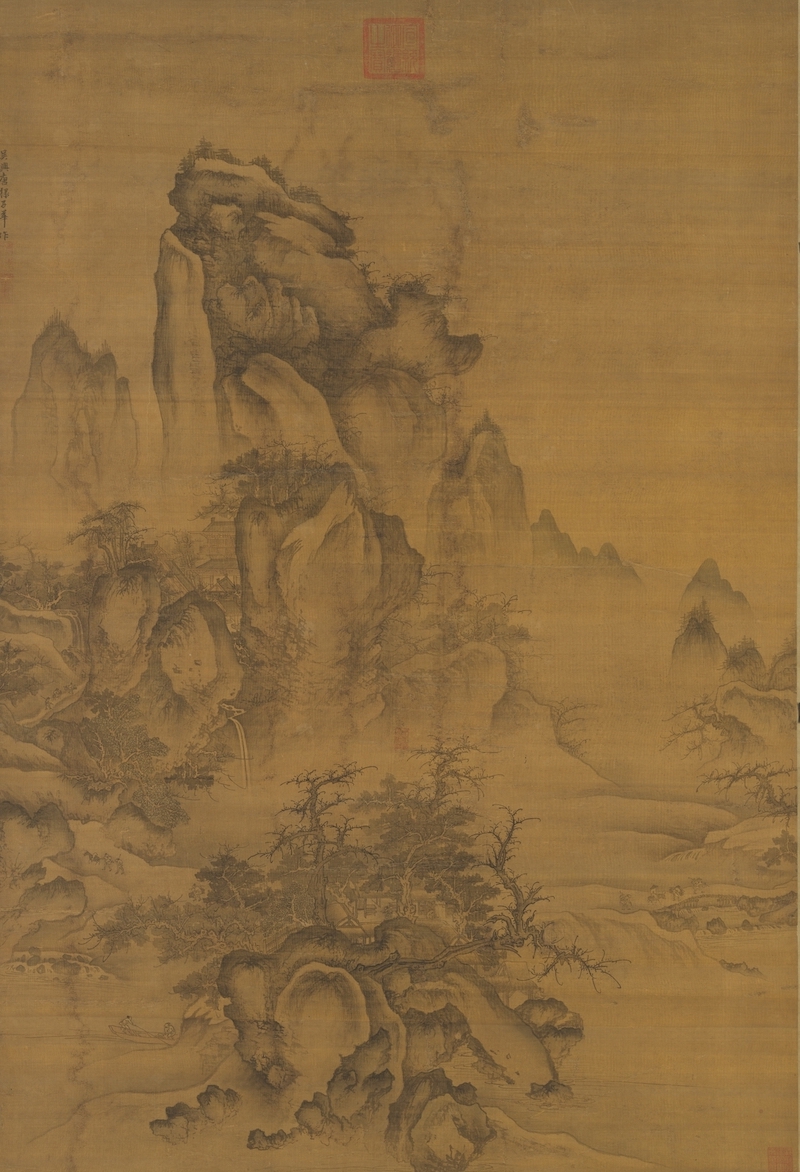
Yuan and Tang Dynasties Imitation Guo Xiqiu Mountain Travel Scroll Collection of the National Palace Museum, Taipei
Tang Di (1296-1364), courtesy name Zihua. Wu Xing (now Huzhou, Zhejiang) was born. He was good at painting landscapes, learned from Guo Xi, and obtained his luscious and luscious taste. He tried to paint the walls of Jiaxi Palace, and he was a valuable person. Painting the cold forest and wild store, the winding path of the rock, decorated with a few people traveling. The peaks and peaks are towering, and the ancient temples are looming in the mountains. This painting adopts the neutral composition of the main peak. The agile mountains and rocks are written with cirrus clouds, and the strong dead branches are written with crab claw brush. All of them are from Guo Xi's brushwork. The whole frame is dyed more than chapped, the mountains and rocks are delicate, the mist is misty, and the atmosphere is comfortable and quiet.
Yuan Zhushu Chongqiu Mountain Pinnacle Axis
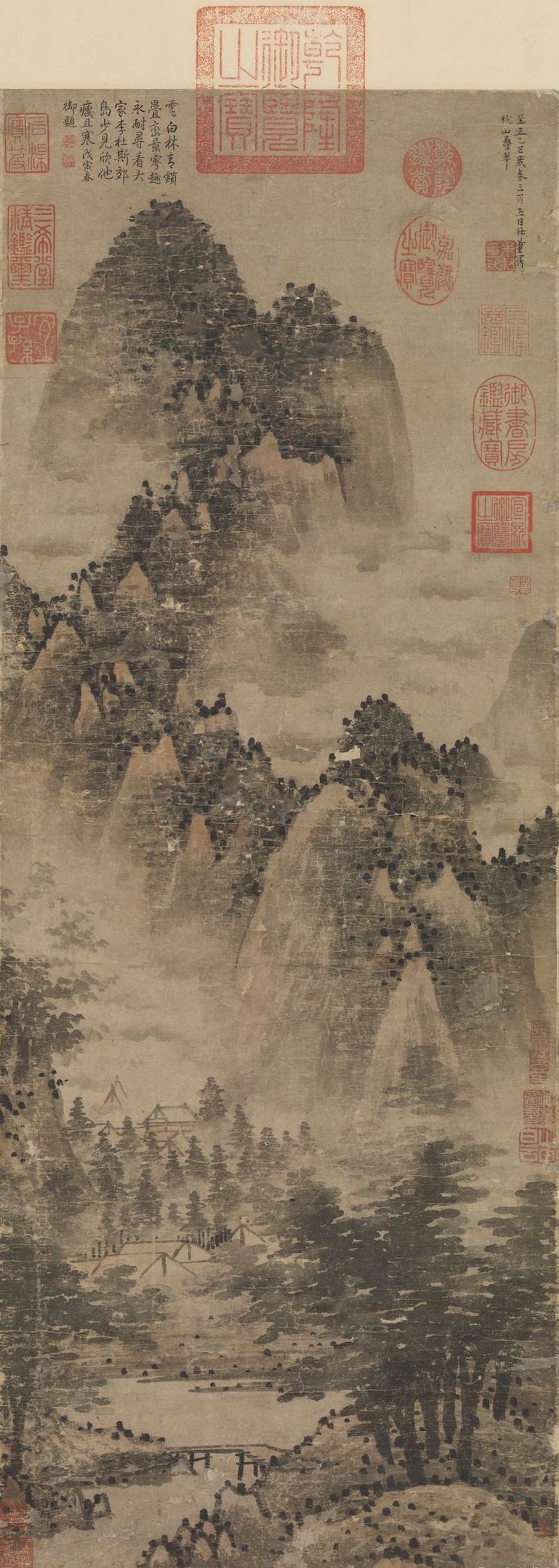
Yuan Zhushu Chongqiu Mountain Pinnacle Scroll (Part) Collection of the National Palace Museum, Taipei
Zhu Shuzhong (about the fourteenth century AD) was also written as Shuzhong, a native of Wuxian, Jiangsu. Although he is a scholar, he also has outstanding achievements in painting, but unfortunately there are very few works left. On the other side of the bridge, there are sparse trees, and four or five village houses are faintly visible. The mountain ridges meander up, and the white clouds are locked in the mountains. Clouds and mountains are green, and the ink is dripping. The mountains are straight and crumpled, and the trees are dotted with horizontal brushstrokes.
Yuanshengmao Autumn River waiting to be crossed

Yuanshengmao Autumn River Waiting to Cross Map Scroll Collection of the Palace Museum
"Autumn River Waiting to Cross" was painted in Xinmao (1351), the eleventh year of Emperor Shun 's reign in the reign of Emperor Yuan. For the Autumn River to be crossed." The second seal. There are also inscriptions inscribed by Laopu, Yingyu'an, Liu Gongxu, Zhuang Guangyi, Yu Ying, and a seven-character poem inscribed by Emperor Gaozong Hongli of the Qing Dynasty in the Yiyou year (1765).
This picture uses a two-stage far-reaching composition method to paint the luxuriant trees near, the undulating mountains in the distance, the Chengjiang River in the middle, the wild geese flying, and the wind blowing the tree branches, creating a clear and autumn atmosphere. On the shore, a one-year-old Confucian man and a book boy sat on the ground waiting to cross, and a boat in the river came with passengers on a scull, and the artistic conception was quiet. The painting method is slightly close to Dong Yuan, and the brush is sparse and sharp, which is a representative masterpiece of Sheng's.
"Ancient Fate Collection" recorded.
Yuan Sheng Mao Qiu Lin Gaoshi map axis

Yuan Sheng Mao Qiu Lin Gaoshi Scroll Collection of the National Palace Museum, Taipei
Sheng Mao (active in the middle of the fourteenth century), a native of Lin'an, Zhejiang (now Hangzhou), later moved to Weitang Town, Jiaxing, Zhejiang, and lived next to Wu Town. Zi Zhao. Good at painting landscapes, flowers and birds, and figures. At the beginning, he learned painting with Chen Lin, and then the technique gradually matured, thus forming his own style.
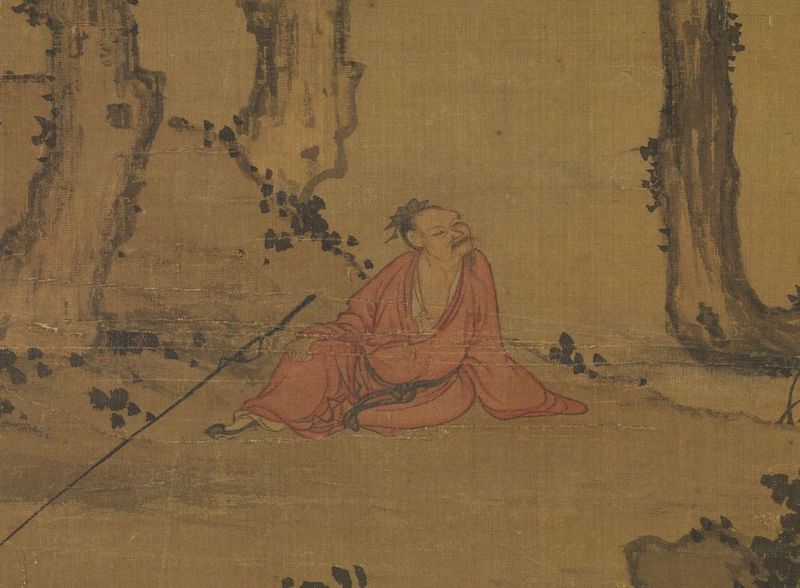
Yuansheng Mao Qiulin Gaoshi's Scroll (Part) Collection of the National Palace Museum, Taipei
In this painting, there is a sparse forest on the banks of the river, and a man in Zhushang is resting and watching with a fishing rod horizontally under the tree. The other side of the mountain is covered with smoke, and the top of the mountain stands above a thousand meters. The trunk is described carefully, the flexural and chapped skin can be touched, and the leaves are mostly single-leafed, neat and orderly, without losing the smoothness. The pen and ink work is skillful and elegant, and the elegant interest overflows at the end of the pen.
Yuanmawan Autumn Mountain Travel Axis

Yuan Mawan Autumn Mountain Travel Scroll Collection of the National Palace Museum, Taipei
Ma Wan (active from 1342 to 1366), a native of Jinling, styled Wenbi, with the name Lu Xun. Good landscape, works poetry, calligraphy, painting. Every time you encounter a beautiful landscape, you must take care of it. There is the method of Dong Yuan and Mi Fu, which is often referred to on the left by himself, and the time number is three unique.
Chong mountains and mountains, travel on a donkey and a lotus. The composition of the whole picture is dense, the brush is mostly center, the ink is simple, and the coloring is elegant. The top of the top is a peak and the brush is sparse and simple, and the flat dots are used to make small trees, which are especially clear and elegant.
There is no author's seal on this piece, but there is an inscription by Dong Qichang on it, which reads: "Ma Wenbi's trip to the mountains in autumn".
Yuan Zhao Yuanxi Pavilion autumn color axis
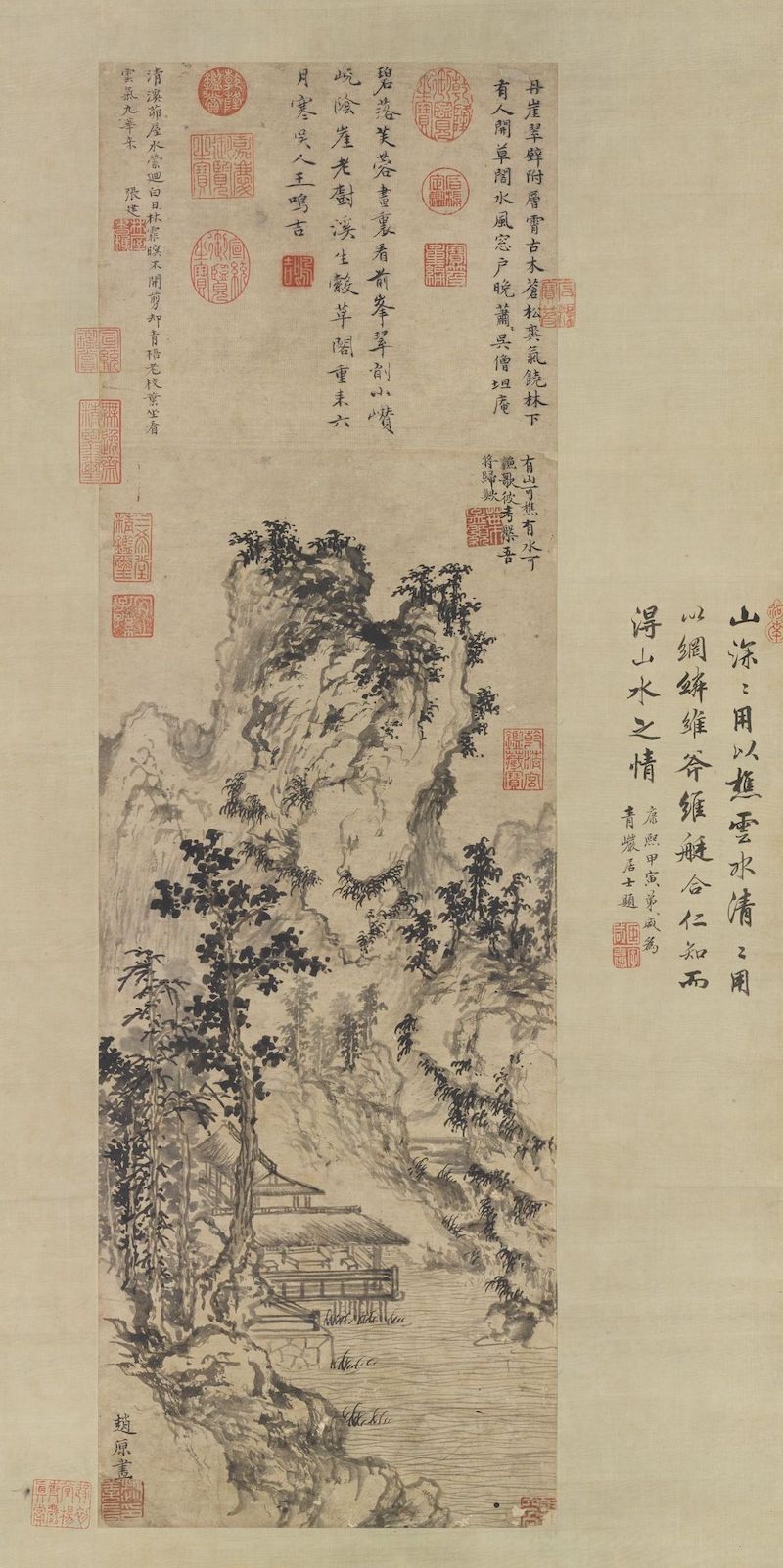
Yuan Zhao Yuanxi Pavilion Autumn Color Scroll Collection of the National Palace Museum, Taipei
Zhao Yuan (about active in the late 14th century), also known as Zhao Yuan, courtesy name Shanchang, no. During the reign of Hongwu in Ming Dynasty, he was called to paint a portrait of a hero and was killed for offending the emperor. Ink and wash paintings of trees and stone water pavilions, in contrast to the sparse and sparse trees near and far. The composition of this picture is concise, the brush is very bald, and the side brushes are mostly used to paint the texture of the mountains and stones, with little rendering, and the intention is natural, showing a simple and elegant interest.
Ming Wang Fuqiujiang Pan Yachting Shaft
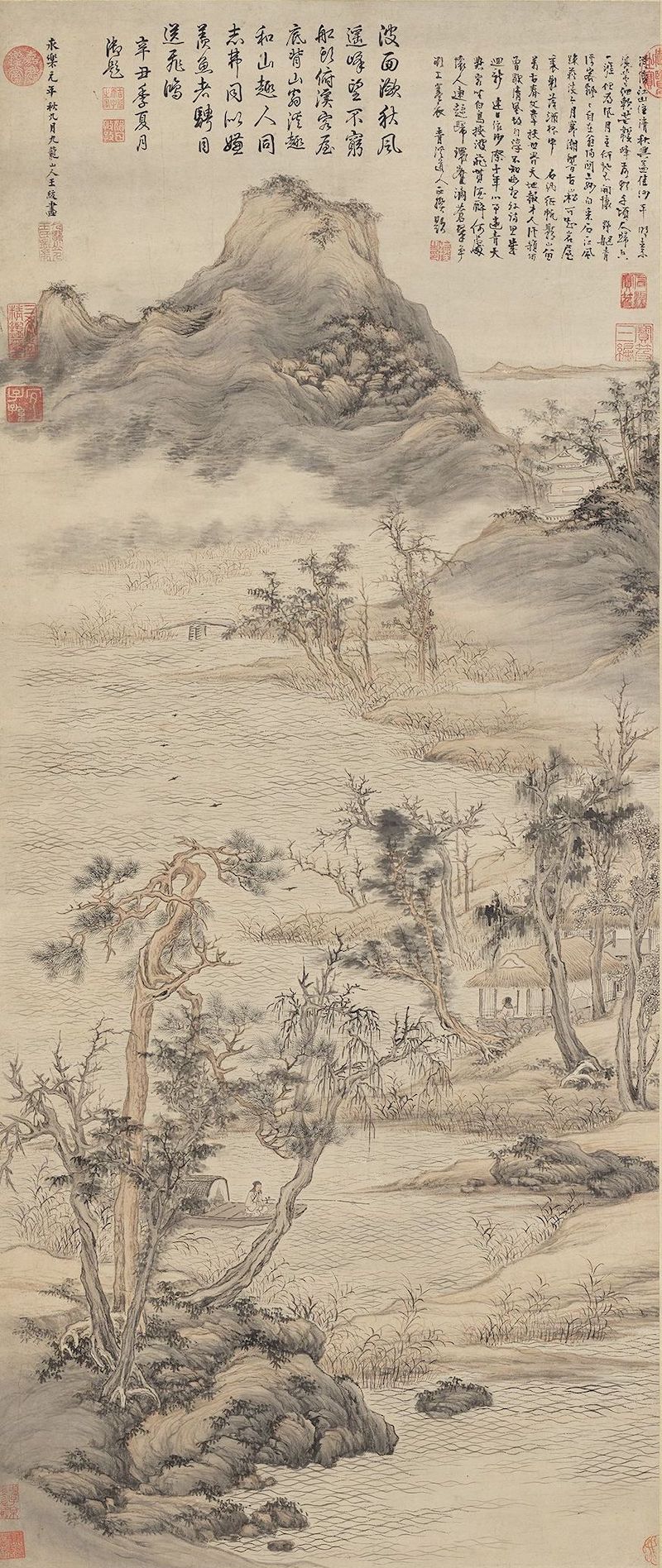
Ming Wang Fuqiujiang Pan Yacht Axis Collection of the National Palace Museum, Taipei
This painting has the inscription of Cheng Zhengkui, a painter and calligrapher in the late Ming and early Qing dynasties: It is good to be near the river and mountains, and the prosperity of Qingqiu is good. Shaping Ming Sulang, reed fine soft awn. The peaks fall for a thousand hectares, and people return only for a short time. But for Fengyue Lord, how can you not be happy. (Second article) The wild boat Qingxi guest, fluttering and free. Yangguan three wonderful sentences, quarrying a river wind. This month, the cold wave is ringing in the ancient Song. It can be seen that in the rock house, the shadow falls into the wine glass. (The third article) Shi Nazheng Fanying, Shanliu eternal spring. Articles help the world, and heaven and earth report talents. The rhyme and river once rested, and the breeze was so sincere. I don't know if you think about it, but the poems are new several times. (Fourth) I have been in the sand for days, and my mind has been violated for ten years. The blue sky hangs with the guest sitting, and the white birds fly with the waves. Where is drunk drunk, pregnant people return quickly. Green cliffs dripping green. Competing to get dressed in cold clothes, Taoist Qingxi is arguing.

Ming Wang Fuqiu River Pan Yachting Shaft (detail) Collection of the National Palace Museum, Taipei
Ming Tang Yin Qiushan

Ming and Tang Yinqiu Mountain Collection of the National Palace Museum, Taipei
Tang Yin was born in the sixth year of Chenghua Emperor Xianzong of the Ming Dynasty and died in the second year of Emperor Emperor Jiajing's reign (1470-1523). The character is Ziwei, and the character is Bohu, and the number is Liuru. Talented and multi-talented, unrestrained by nature, wild and uninhibited. In the eleventh year of Hongzhi (1498), he was tried to resolve the Yuan in Nanjing Township. He was later implicated in the bribery case in Beijing, and was exiled as an official. The autumn water is long and the sky is bright and clean. The fisherman carries the net and walks on the embankment. The three or five withered trees are paired with turning red leaves, and the empty and sparse scene reveals the bleakness of autumn. Tang Yin used fluent and slender lines to express the mountains and rocks near the shore. The trees are also quite beautiful. The rocks are dyed with ochre red, which is just the reflection of the sunset, and the afterglow is eye-catching.
This piece is selected from the book "Collecting Ancient Drawings".
Mingwen Boren Creek Mountain Autumn Ji Axis

Mingwen Boren Creek Mountain Autumn Ji Axis Collection of the National Palace Museum, Taipei
Wen Zhengming's long-axis paintings like to layer mountains and rocks to form a refined and towering mountain body. Although Wen Boren's "Autumn Ji in Mountains and Streams" is long and narrow, the trees and streams in the painting do not focus on showing the towering heights, but use the perspective of looking down to express the depth. Cezhang Gaoshi crossed the arc-shaped stone bridge with the base of the rectangular bridge column, and then walked along the jagged path along the stream to the side of the hermit's hut who was resting on the bed. Going deeper, you can stand beside two towering pine trees, overlooking the calm pool, the columnar rocks on the opposite bank, and the distant mountains towering above the thick clouds. This picture was painted in Ding Weinian (1547), Jiajing. Although it belongs to Wen Boren's early work, it is a masterpiece that has developed its own identity.
Zhao Zuoqiu Mountain mangrove map in Ming Dynasty
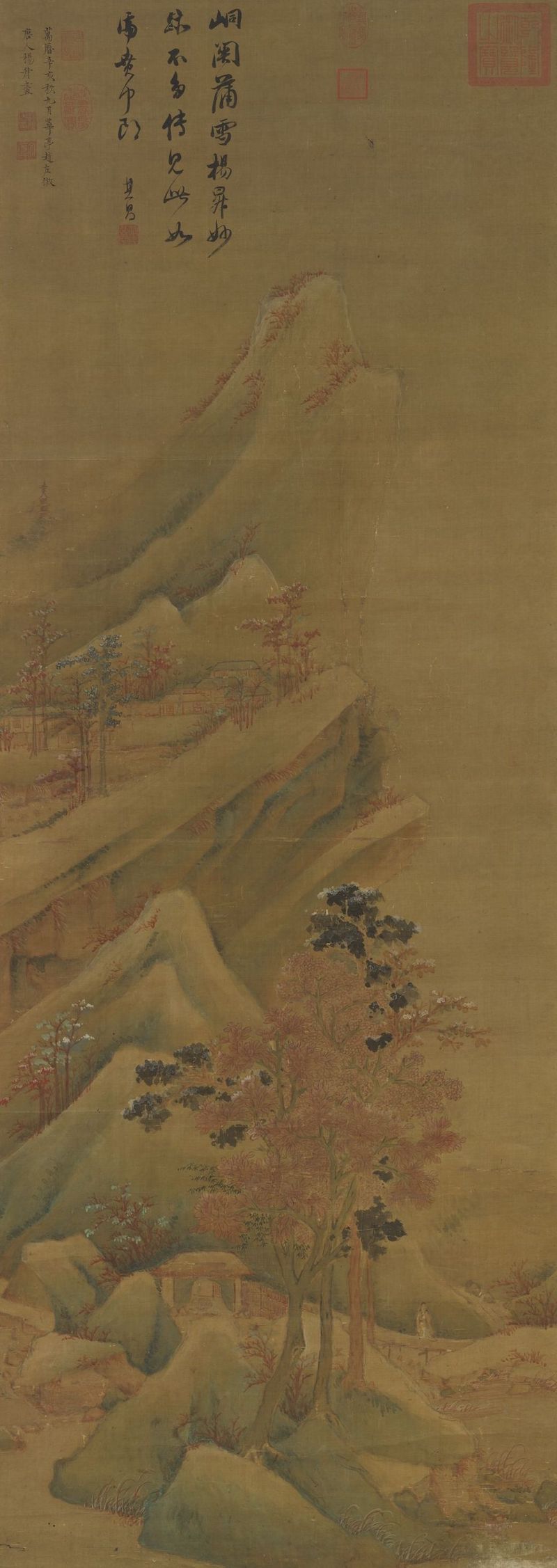
Zhao Zuoqiu Mountain Mangrove Scroll of Ming Dynasty Collection of the National Palace Museum, Taipei
Zhao Zuo (about the 16th century), with the character Wendu, was born in Songjiang, Jiangsu. Good at painting landscapes, he is the founder of the Su Song School of Painting. In the painting, Zhao Zuo himself inscribed "Imitating Yang Sheng's painting of Tang Dynasty". According to Yang Sheng's paintings of landscapes, Zhang Sengyao's boneless method was obtained. There are Xue Ji pictures and Pu Xue pictures in Tongguan that have been handed down to the world. This painting is mostly colored with blue and green, and the mountains and rocks are not stained with chapped patterns, but stained with the boneless method. However, Zhao Zuo was deeply influenced by the paintings of the Wu school, so he was not as gorgeous and rich as Tang paintings, but had a gentle and elegant taste.
Mingguan Siqiulin listens to the spring axis
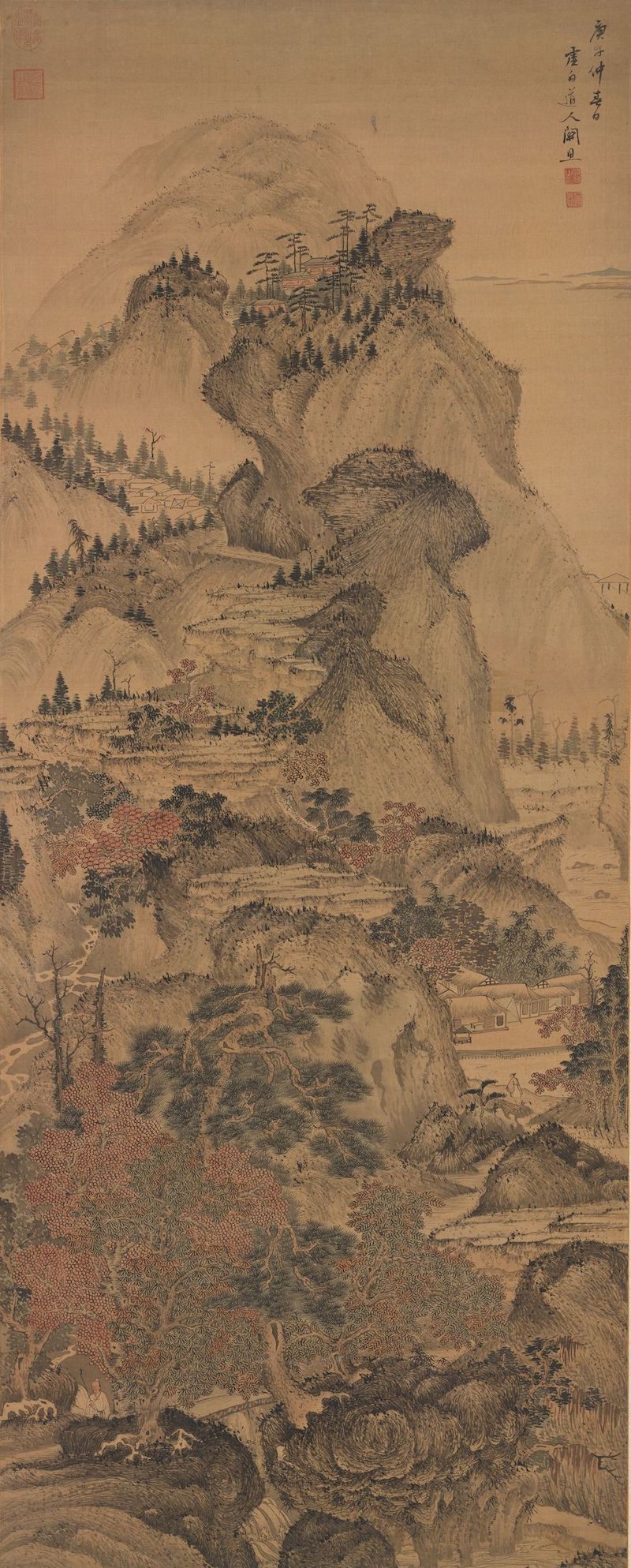
Ming Guan Siqiu Forest Listening Spring Scroll Collection of the National Palace Museum, Taipei
Guan Si, a native of Wucheng, with a courtesy name of He Si, a nickname of Xubai, a name of Jiu Si, a courtesy name of Zhongtong, and a good landscape. Wanli is as famous as Song Xu. Existing paintings, the earliest in Wanli Gengzi (1600), the latest in Chongzhen Gengwu (1630, the date of death is unknown.
This is one of the earliest frames of Guan painting handed down from generation to generation. The whole area is full of mountains and rivers, and I do everything I can. Press the top of a peak, the farther away the lighter. Outside the peak, I used green ochre to drag across the far bank, and then I felt the vastness of the river and the sky. It can make people's hearts get rid of the filth and filth, but it can be complicated but not thick, and it can be skillful but not clear. It is a small debt.
Qing Dynasty King Shimin Qiushan White Cloud Chart Axis
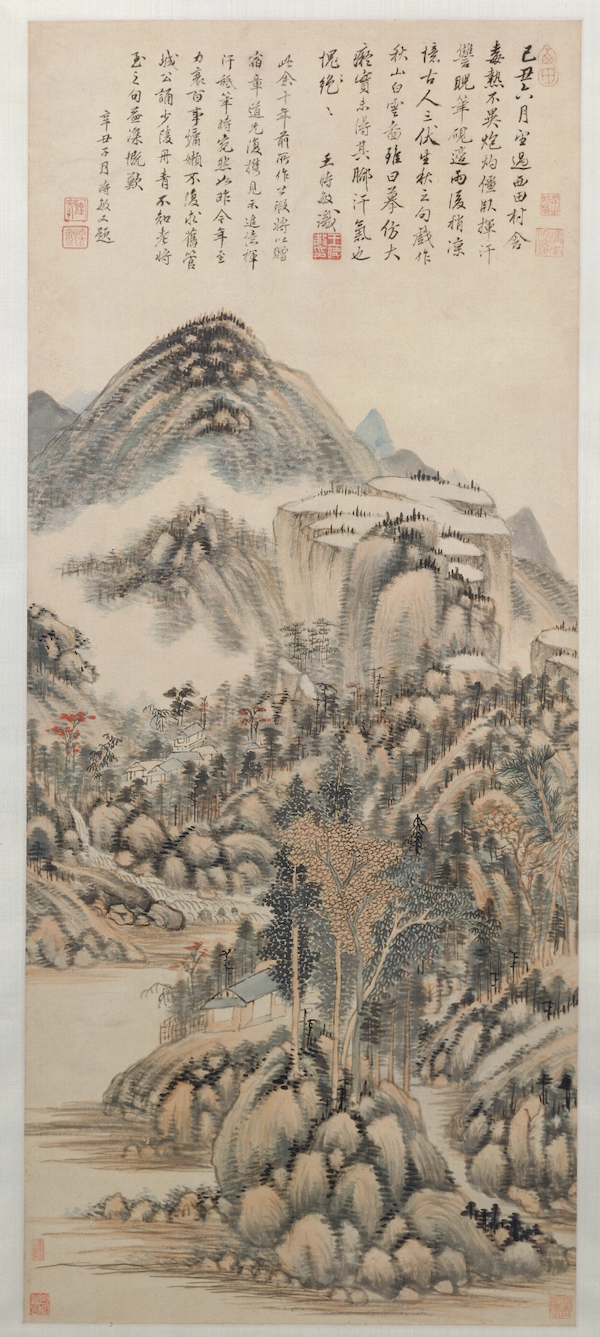
Qing Dynasty King Shimin Qiushan Baiyun Chart Scroll Collection of the Palace Museum
The picture depicts a mountain view after the rain with vast smoke and clouds and lush forests. According to the title of the inscription, this picture is an autumn landscape picture made by the author after the rain in the midsummer, imitating the style of Huang Gongwang, a native of the Yuan Dynasty. Since Wang Shimin resigned from office in the fifth year of Chongzhen in the Ming Dynasty (1632) and returned to his hometown, he devoted himself to the study of paintings of the Song and Yuan families. During this period, he created a large number of works that imitated Huang Gongwang. "Crimson" painting style masterpiece. The brushwork is loose and flexible, the color and ink are varied and layered, and the overlapping and interlaced ink dots organically unify the mountain shape and tree appearance in the high and elegant realm.
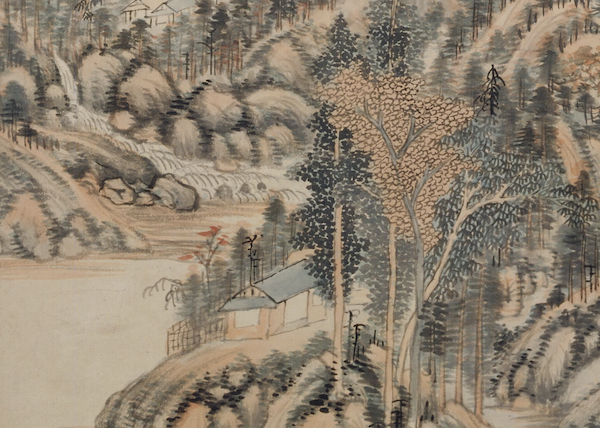
Qing Dynasty King Shimin Qiushan White Cloud Scroll (Partial) Collection of the Palace Museum
The inscription: "I was ugly in June and looked at the Xitian village house. The poisonous heat was the same as the cannon burning. I was lying on the bed and sweating. Although it is said to imitate the big idiot, it is really not the sweat of his feet, and he is absolutely ashamed. Wang Shimin knows it." "Wang Shimin Yin" Bai Wen Yin, "Xi Tian" Zhu Wen Yin. Another title: "The remaining ten years ago, Gong Xia will present it to Brother Su Zhang. I will bring it back to see the show, and recall the time when I was sweating and licking my pen, just like yesterday. Guan Chenggong, reciting Shaoling's sentence 'Danqing does not know the old man will come', he sighed deeply. Xin Chouzi also asked the question again in the month." Zhuang "Smoker", "Ru Zhai" Zhu Wenyin two parties. "Ji Chou" was the sixth year of Shunzhi in the Qing Dynasty (1649), and the author was 58 years old. "Xin Chou" dates from the eighteenth year of Shunzhi in the Qing Dynasty (1661), when the author was 70 years old.
Qing Dynasty King Hui Qiushan ten thousand weight map

Qing Dynasty King Hui Qiushan Ten Thousand Layers of Chart Scroll Collection of the Palace Museum
The artist at the top left of this painting inscribed a seven-character quatrain, and the inscription reads: "Imitate Huang Zijiu's Qiushan brushwork, Gengchen August, Haiyu Wang Hui. On the Mid-Autumn Festival, it will be re-painted and sent to Emperor Xi Daoweng. Hui is also known." "The seal of Wang Hui", "Nine times at sixty years old", "External History of Farming and Tobacco", "Old Man Qinghui" and "Chang Huai" are printed on five sides. This painting was created in the thirty-ninth year of Emperor Kangxi of the Qing Dynasty (1700). It was created by Wang Hui imitating the painting of Huang Gongwang, a famous painter in the Yuan Dynasty, to describe the autumn mountains and forests. Wang Hui was 69 years old. From the inscription, it can be seen that the painting was completed in early August, and it was given to friends after it was repainted during the Mid-Autumn Festival. The collection is printed with two sides: "Dr. Zhang Qinglian's collection in Yushan" and "Chen's family collection".
The picture depicts the late autumn scenery in the Yushan area of Changshu, with a strange and secluded realm. The seven-character quatrain inscribed by the artist himself , "There are thousands of autumn mountains in the distance, I want to pick hibiscus when I am drunk. Where is the peak of the peak to sing and call for seclusion, so Danqiu is not easy to meet", which makes the picture more poetic and beautiful. Wang Hui's paintings follow Huang Gongwang's style, but he does not stick to one style. His landscape painting skills are profound, similar to ancient times, and his sketching is also innovative. Although this painting is a social work, it has no sloppy habits. The painting method is a little bit like Huang Gongwang's light-red landscape. The brush and ink are skillful and delicate. Wang Hui is a long-lived painter who has created many works. His landscape paintings have changes in three periods: early, middle and late periods: before the age of 35, he is in the early period, mainly imitating antique paintings, and his brush and ink are immature; between the age of 35 and 60, the middle period is Drawing on the strengths of various families in the north and the south, he has a variety of appearances, and is skilled in writing and ink. He is known as "the first in China"; after the age of 60, he is in the late stage, and his techniques are more proficient. Wang Hui once said that landscape painting should "use the brush and ink of the Yuan people, transport the Qiu He of the Song Dynasty, and Zee with the charm of the Tang Dynasty, which is a great success", and this painting reflects his view of painting.
This painting was transferred by Professor Zhang Qinglian of Peking University in 1998 and purchased by the Palace Museum.
Qing Dynasty Emperor Gao Qiushan Xiao Temple Scroll
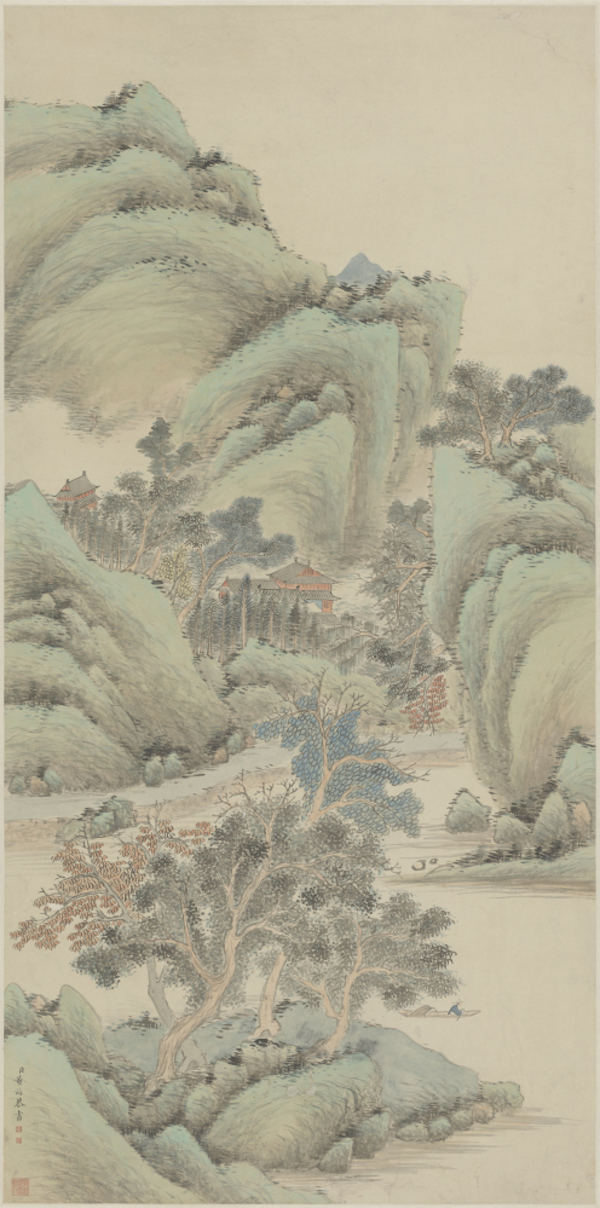
Qing Dynasty Emperor Gao Qiushan Xiao Temple Map Scroll Collection of the Palace Museum
Dong Gao (1740-1818), courtesy name Xijing, no. Son of Bonda. In the twenty-eighth year of Qianlong's reign (1763), he was a Jinshi, an official to the Cabinet of Ministers. Posthumous Wen Gong. Gongshi ancient prose, calligraphy zong Wang Xizhi, presented it. Shanshui inherits family learning, and is elegant and exquisite. In the late Song and Yuan Dynasties, he was known as the big and small Dong. He was a man of change, and he taught him how to paint for a while.
The picture is a stagnant water, with towering green mountains on the other side, and ancient temples and temples in the depths of the forest. enjoying the moment. The composition is far-reaching, combined with a bird's-eye perspective, and the scatter perspective method is used to create a situation, which increases the sense of grandeur of the space. In terms of technique, the mountain body is rubbed, rubbed, dyed and dyed, the finely broken lines are imitated by the method of cattle hair, and the brushwork is intentional; the branches and leaves of trees are used for both marking and writing; the temple uses OEM to express the effect of world painting. It is a small blue and green landscape, with azurite, cyan, stone green and juice green, water, ink and color blending, presenting a unique color effect of "thick and thin, beautiful and elegant". This piece is a work by the painter of Cichen, which coincides with the Zen meaning of "The pines are not old, and the clear water is free from dust" in the axis of the poem Yuan Wangmeng "Qiushan Xiaosi" written by Emperor Qianlong. The word "Chen" is dropped, and the word "Chen" is stamped. The size is large, it is ornamental, the color is bright and elegant, and it has the charm of literati elegance. It is in the old collection of the Qing Palace.
(This article is compiled from the relevant materials of the Palace Museum and Taipei Palace Museum.)
